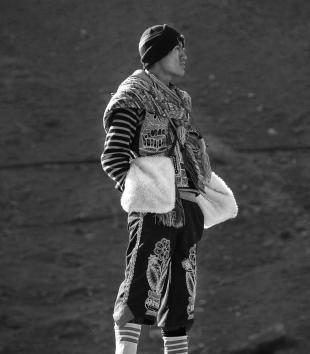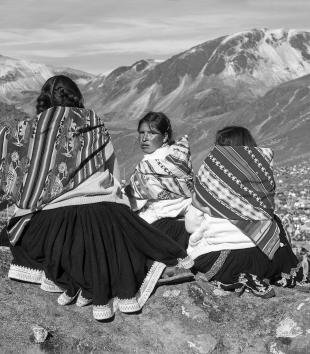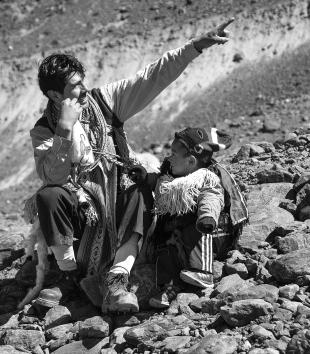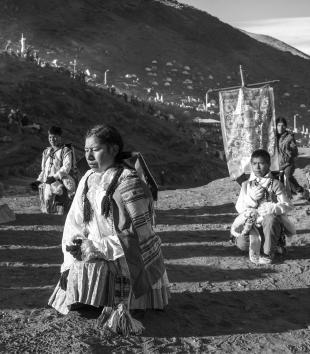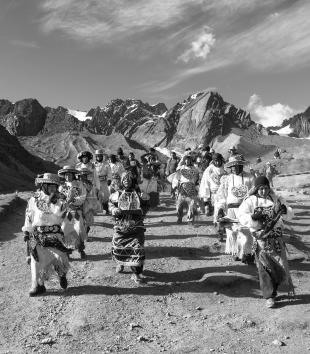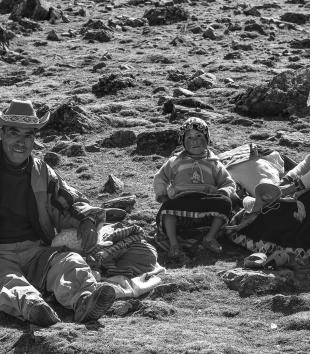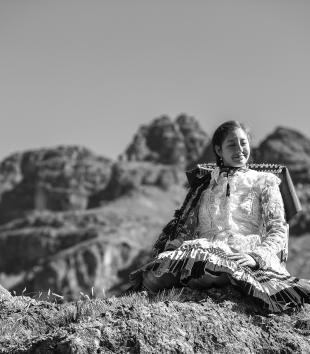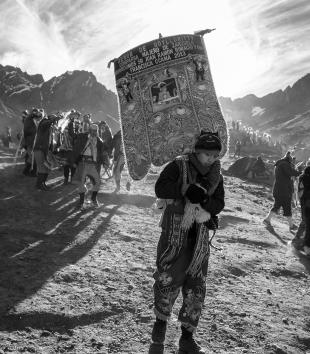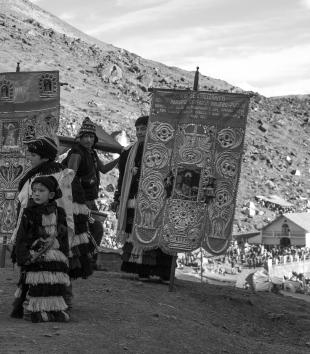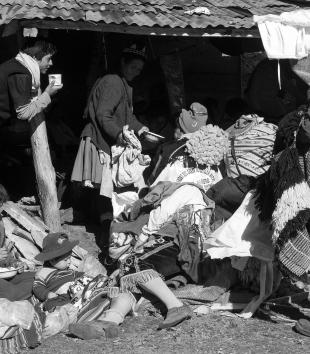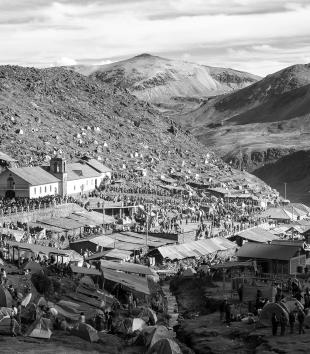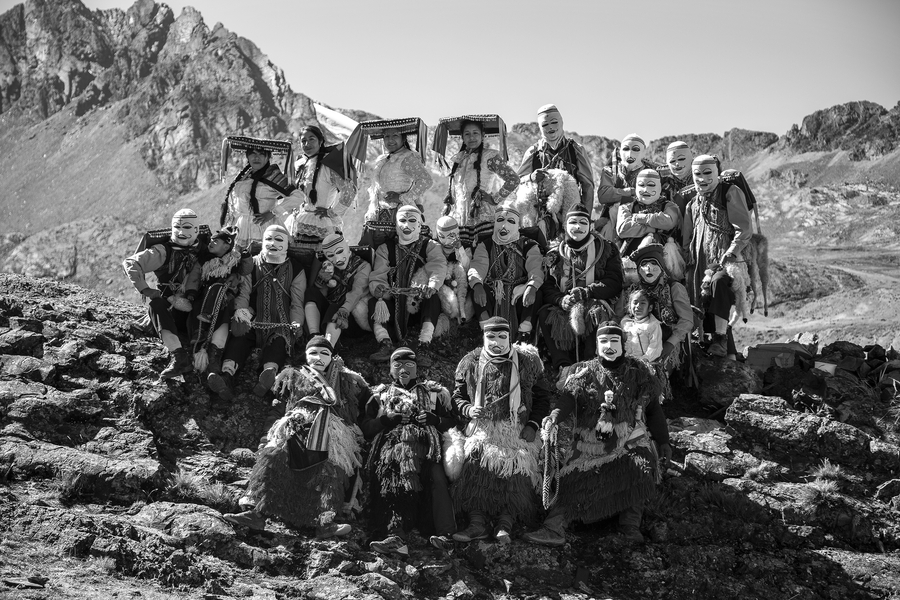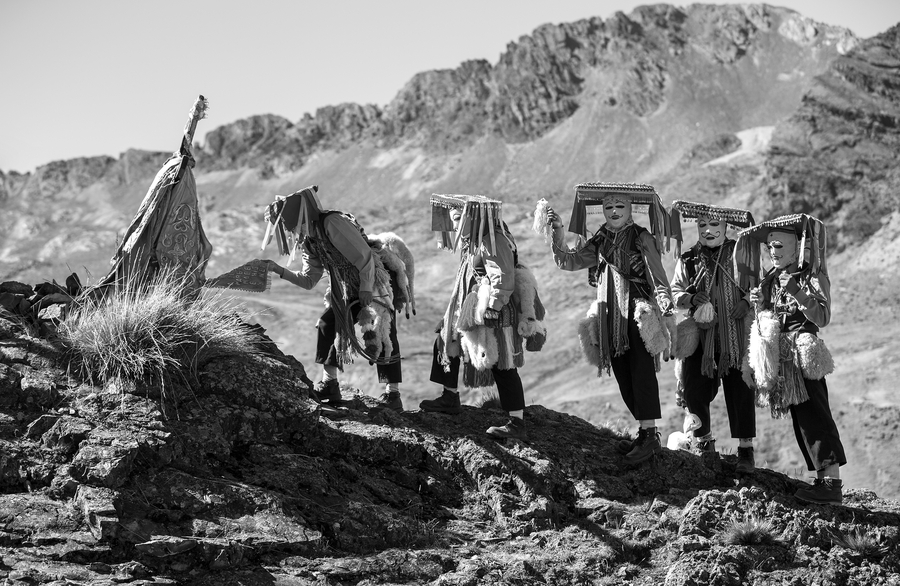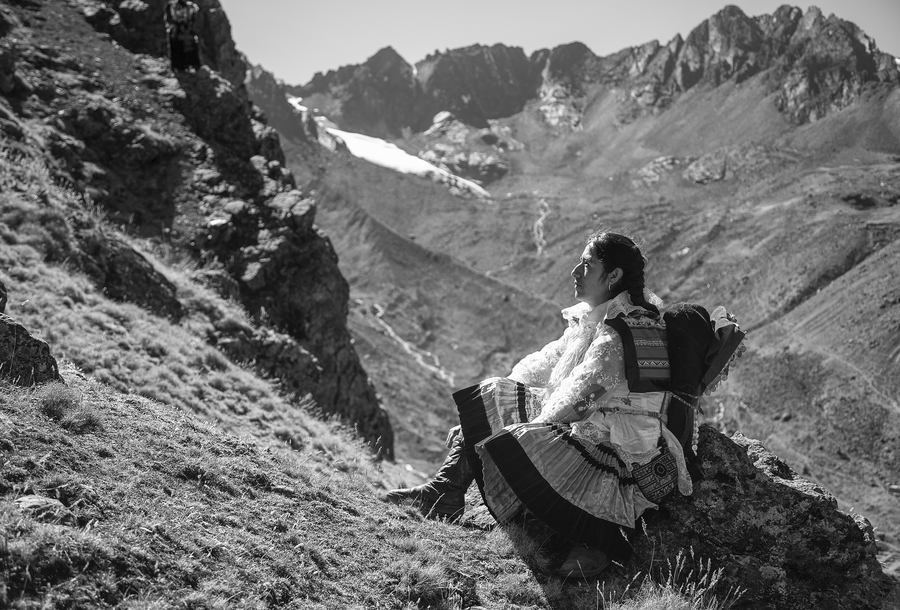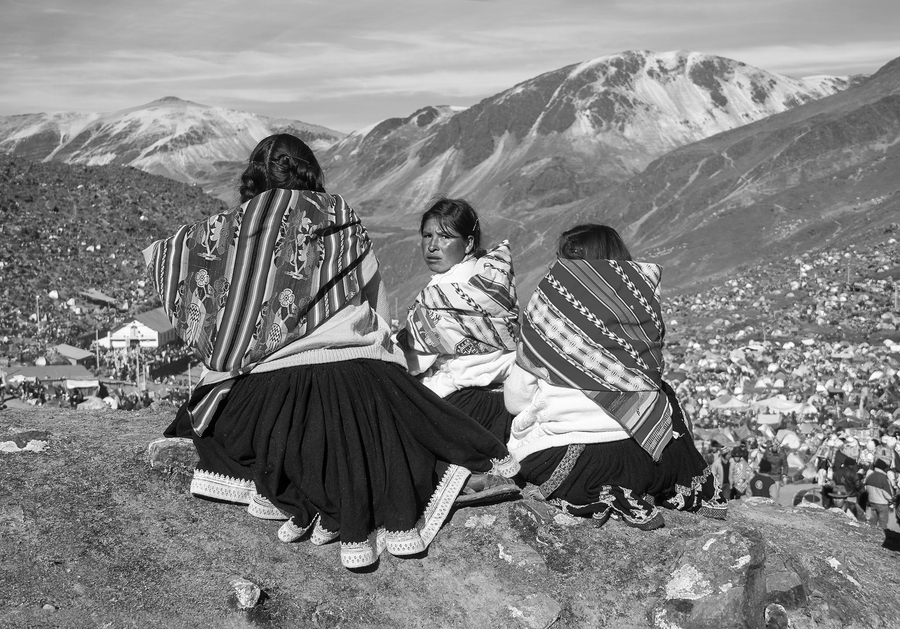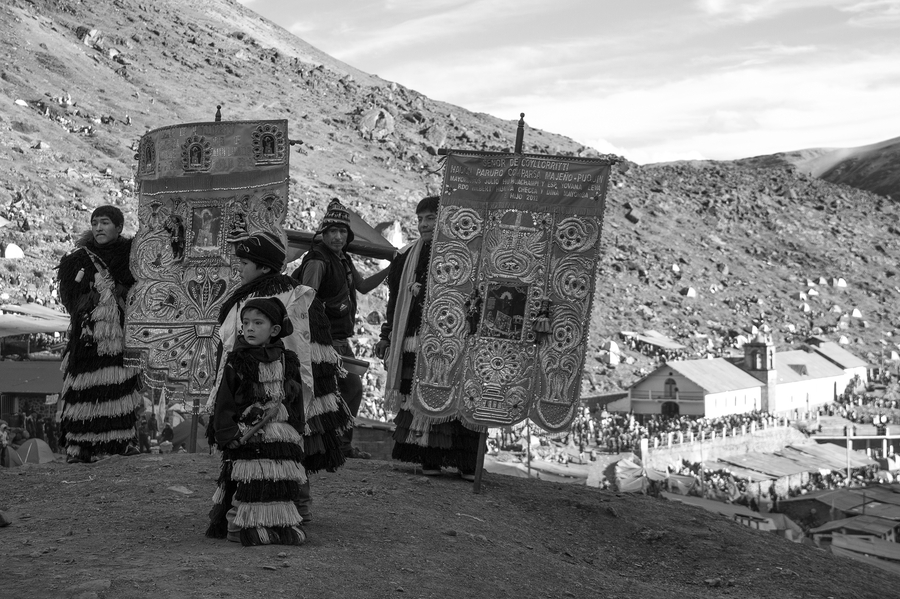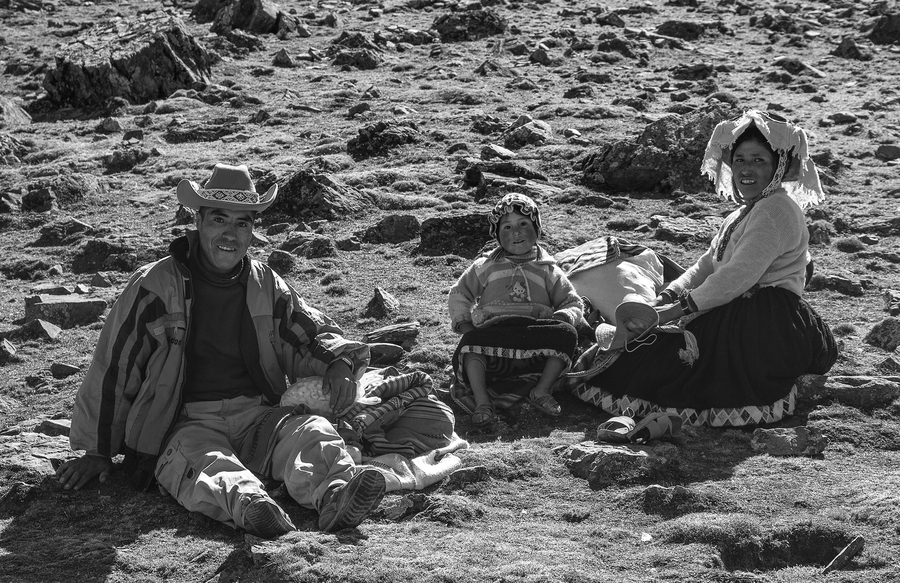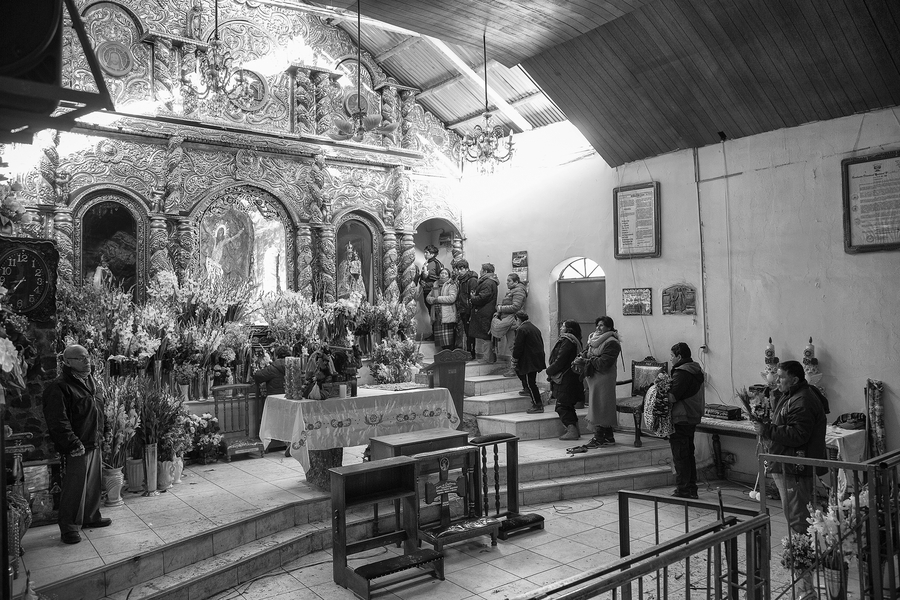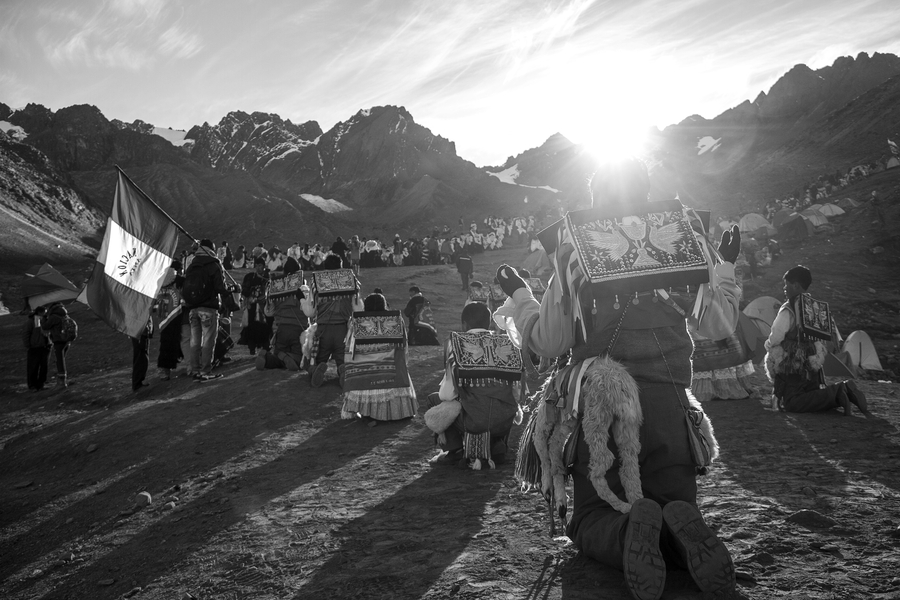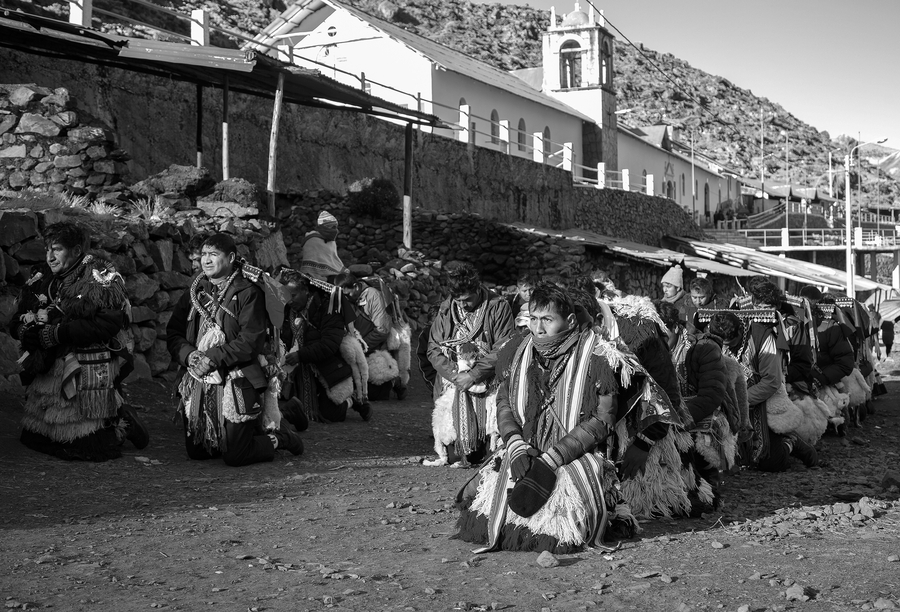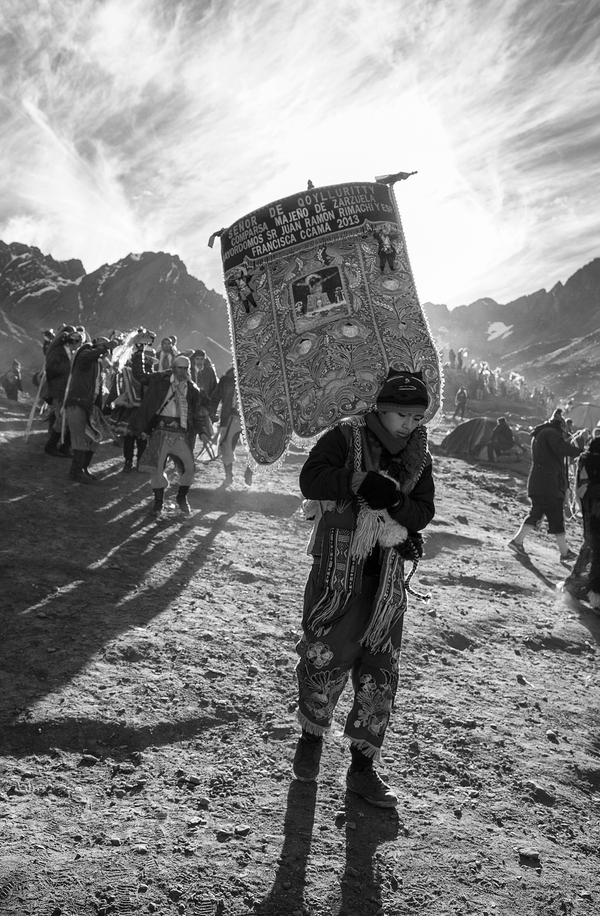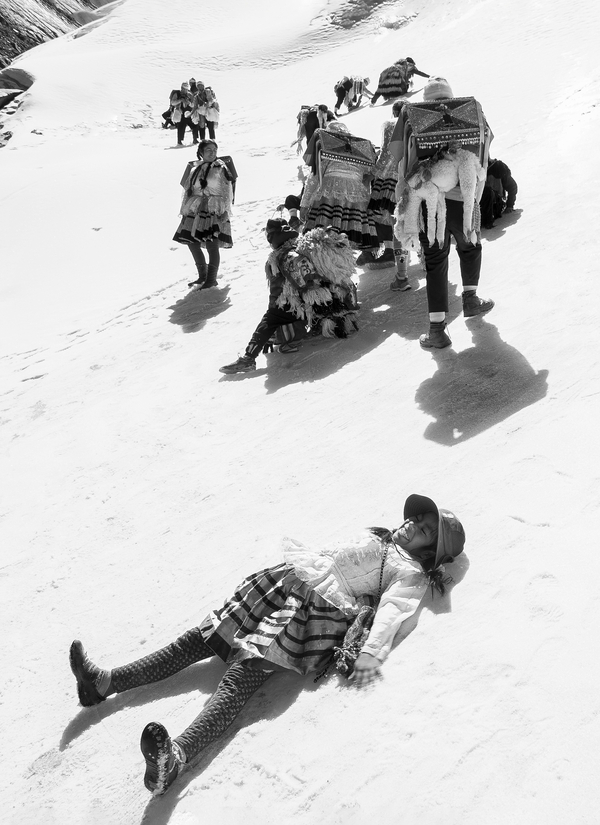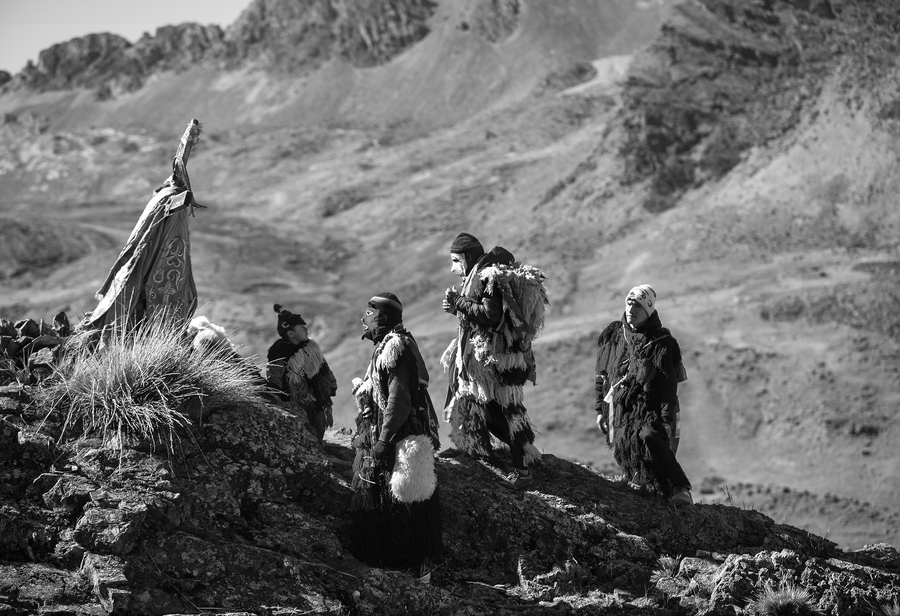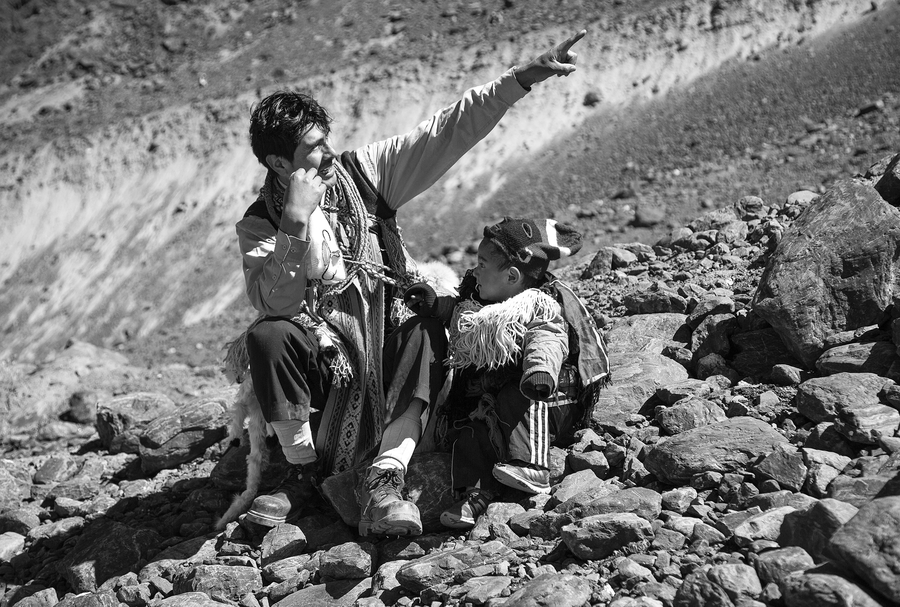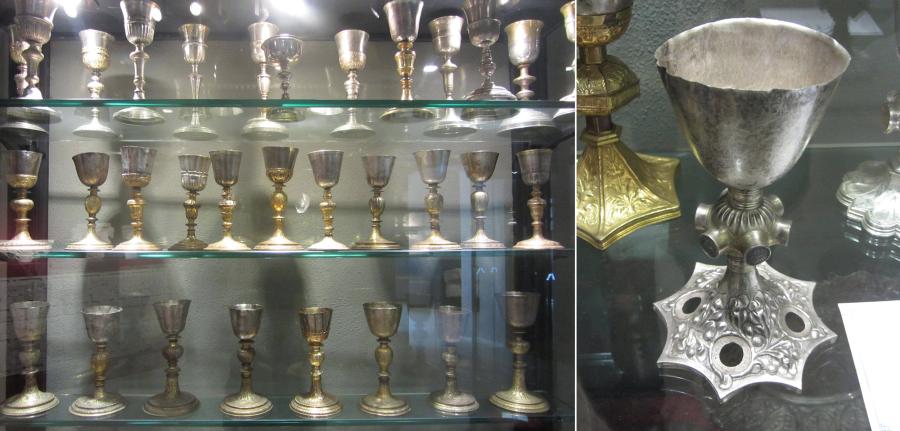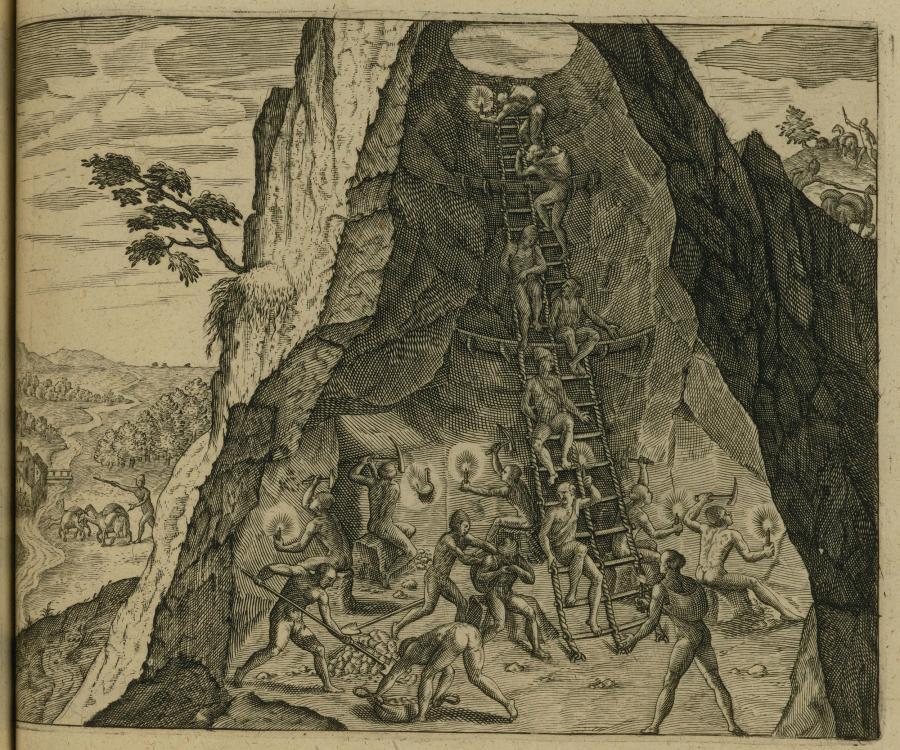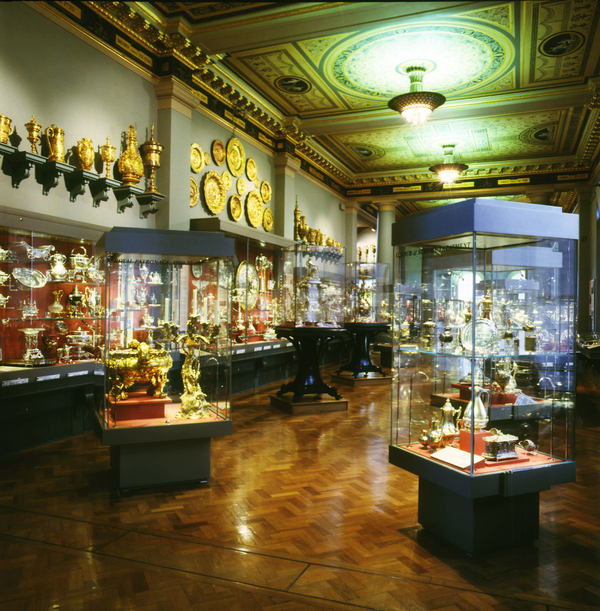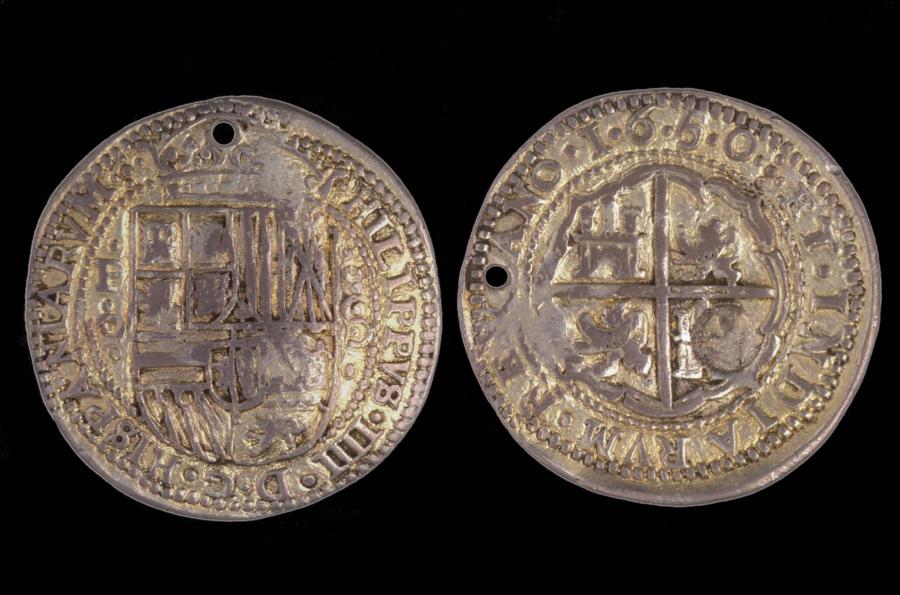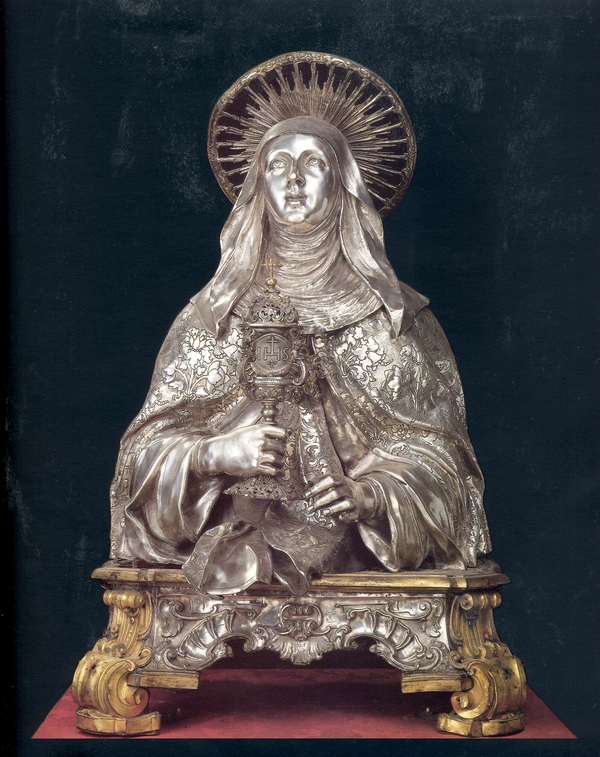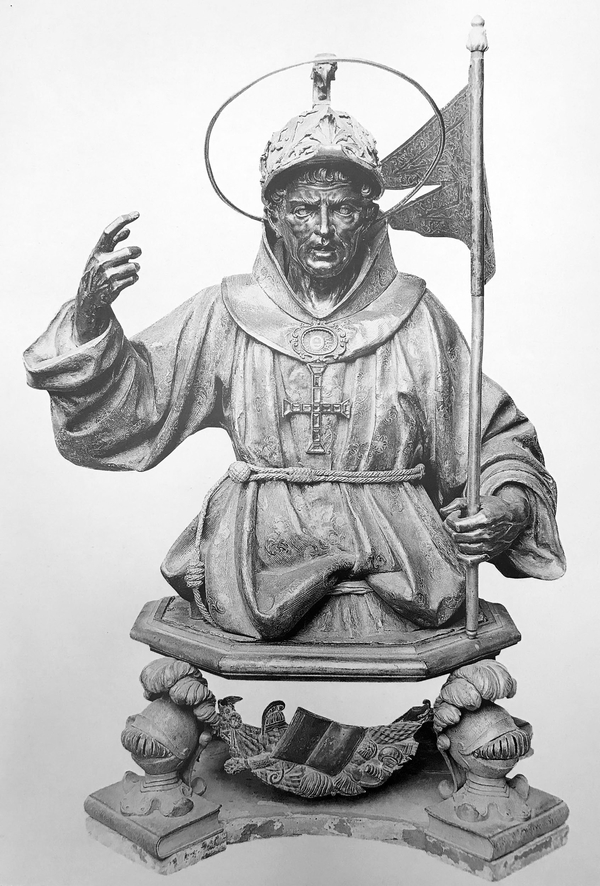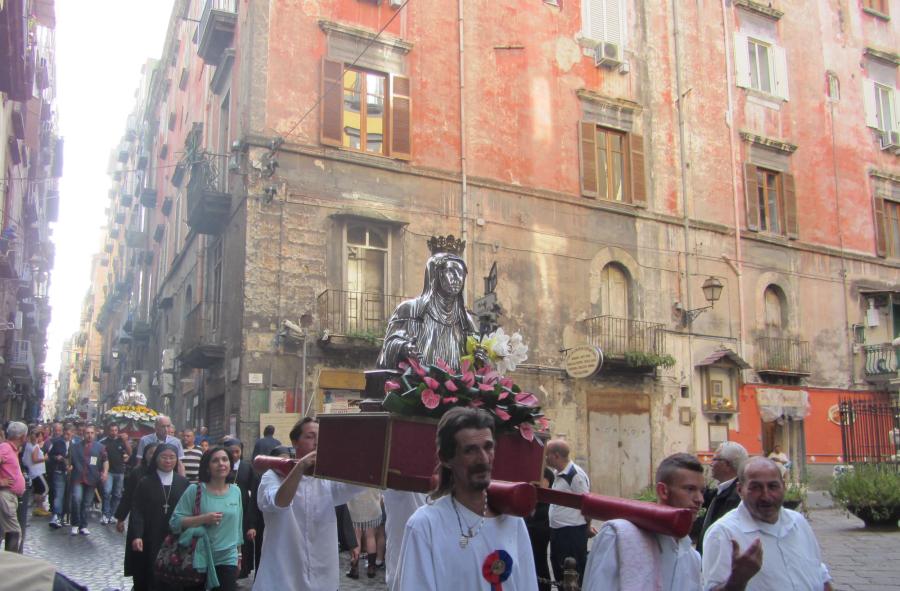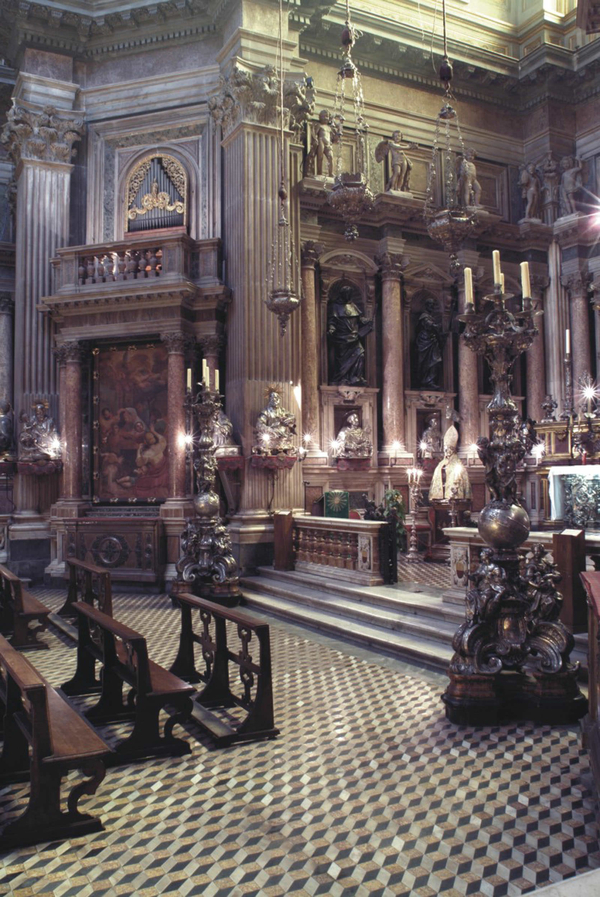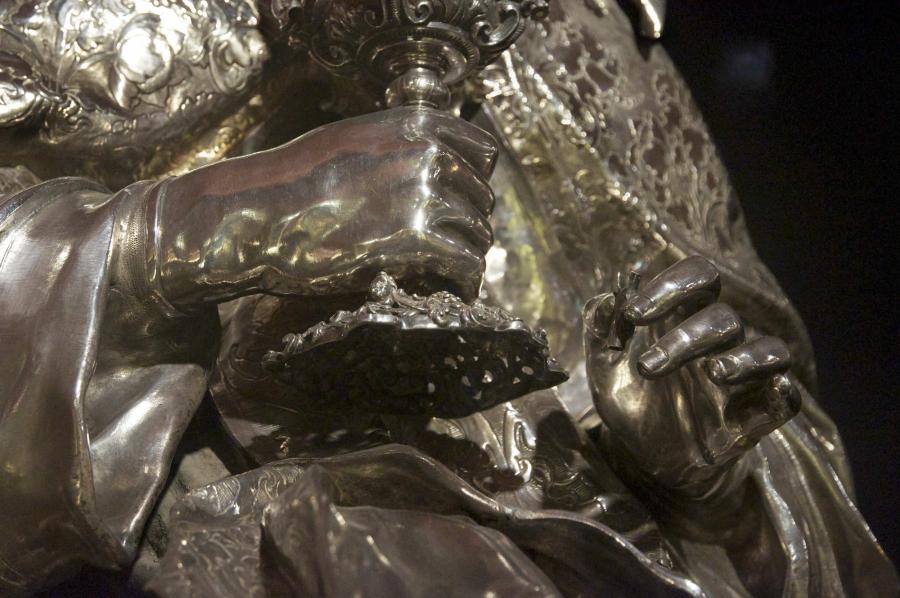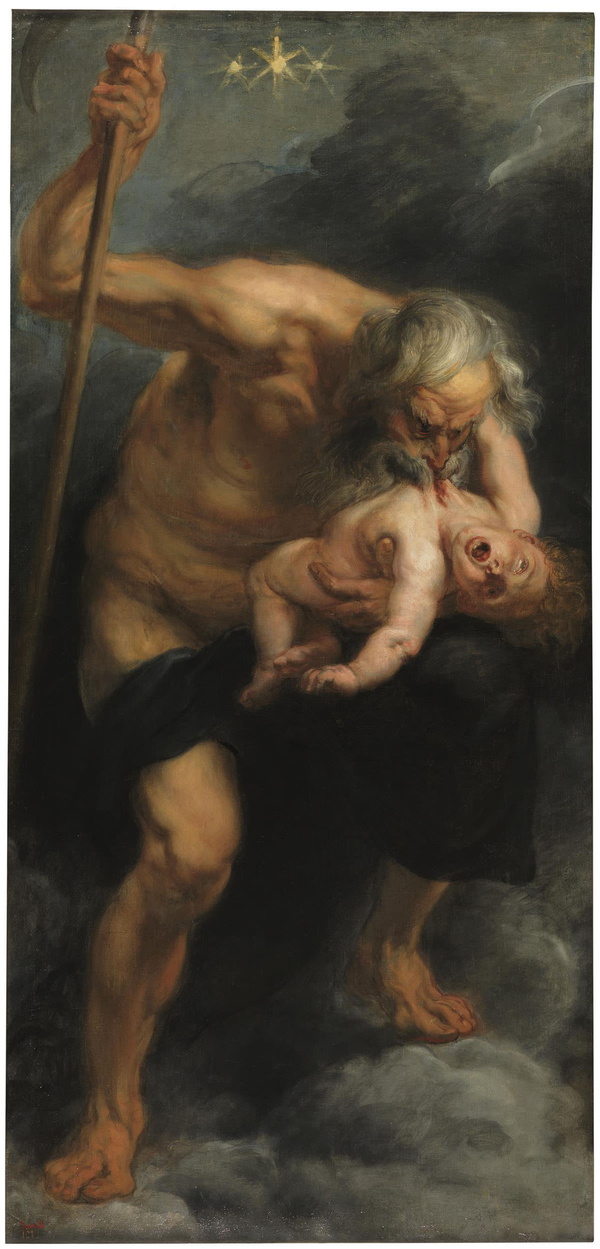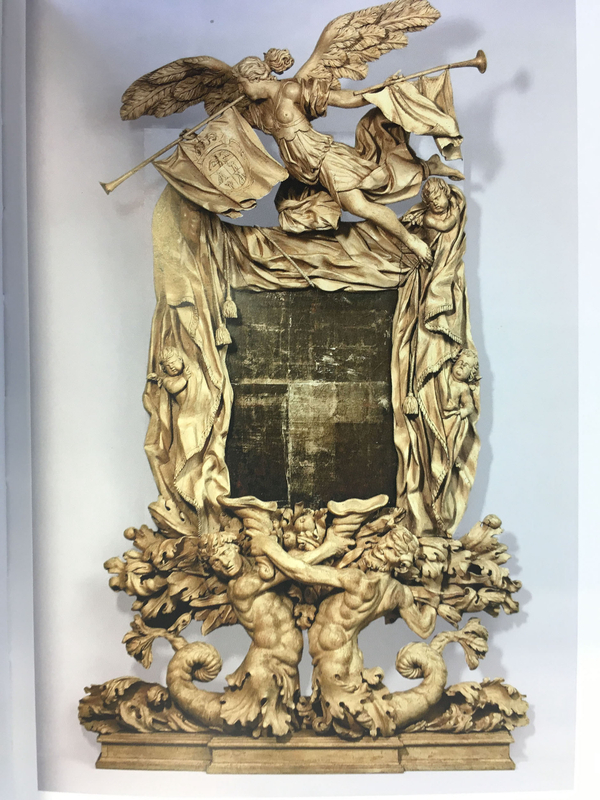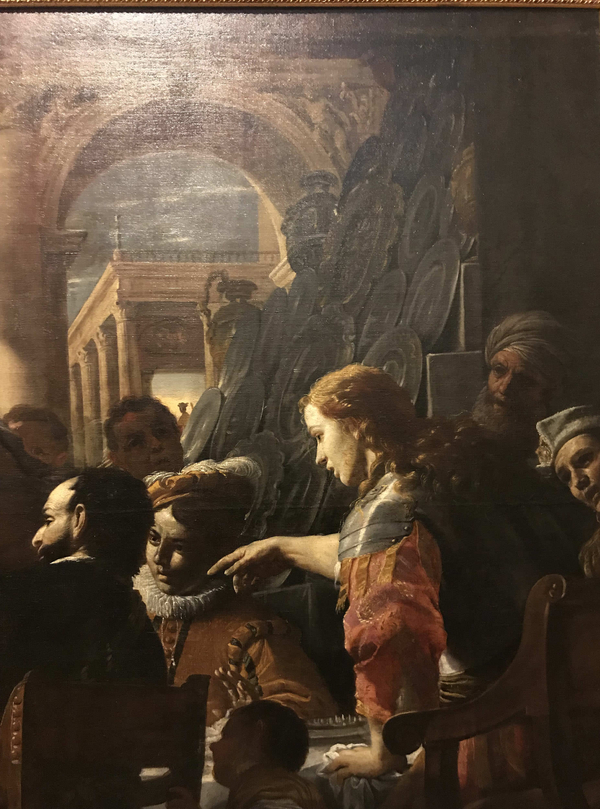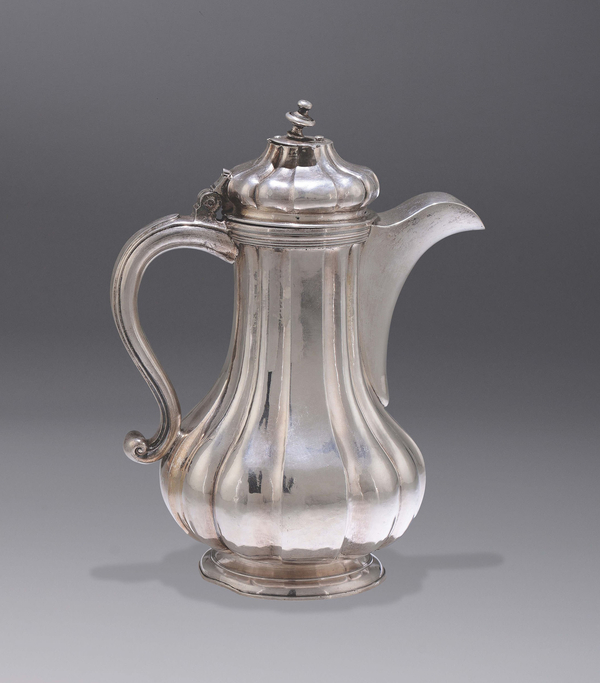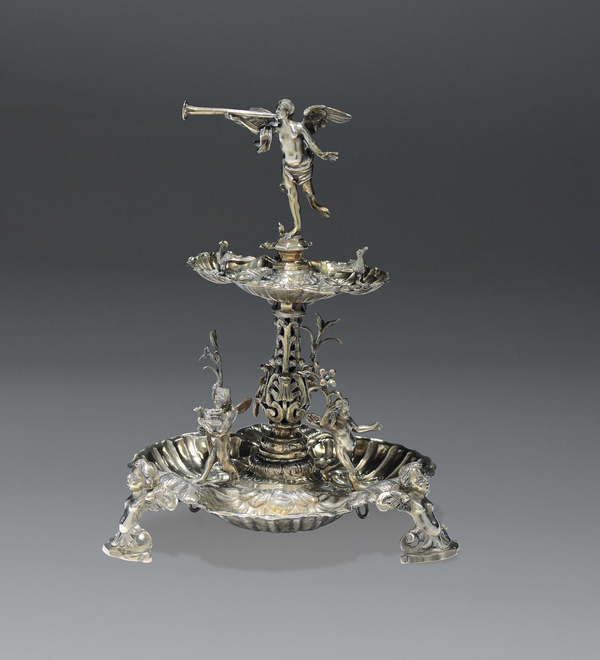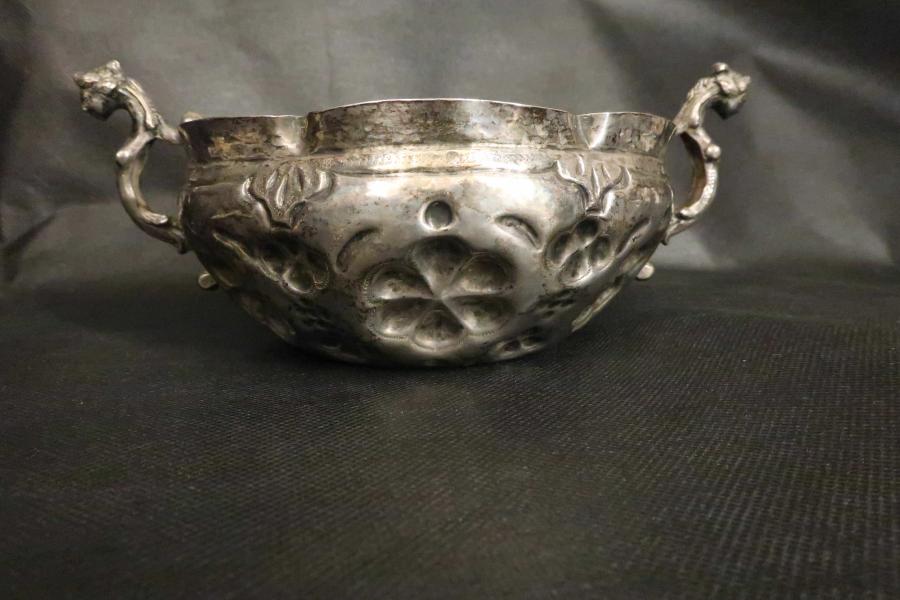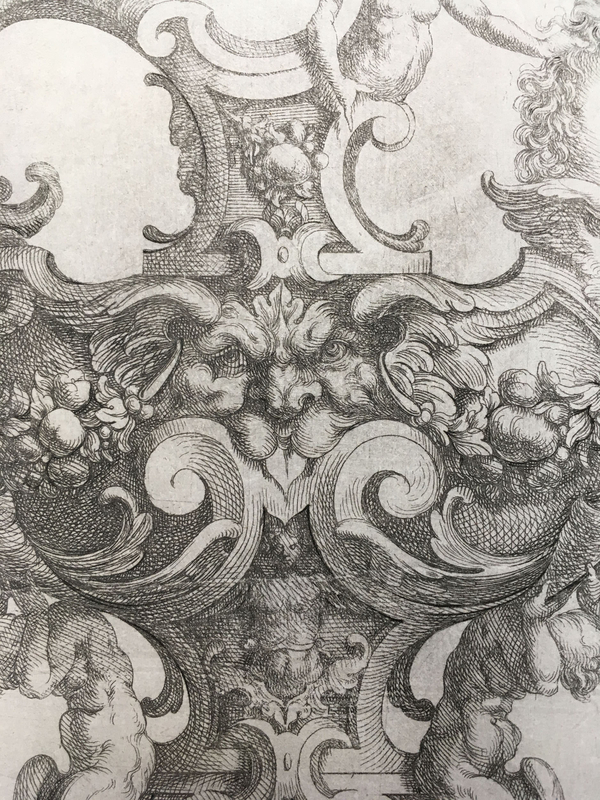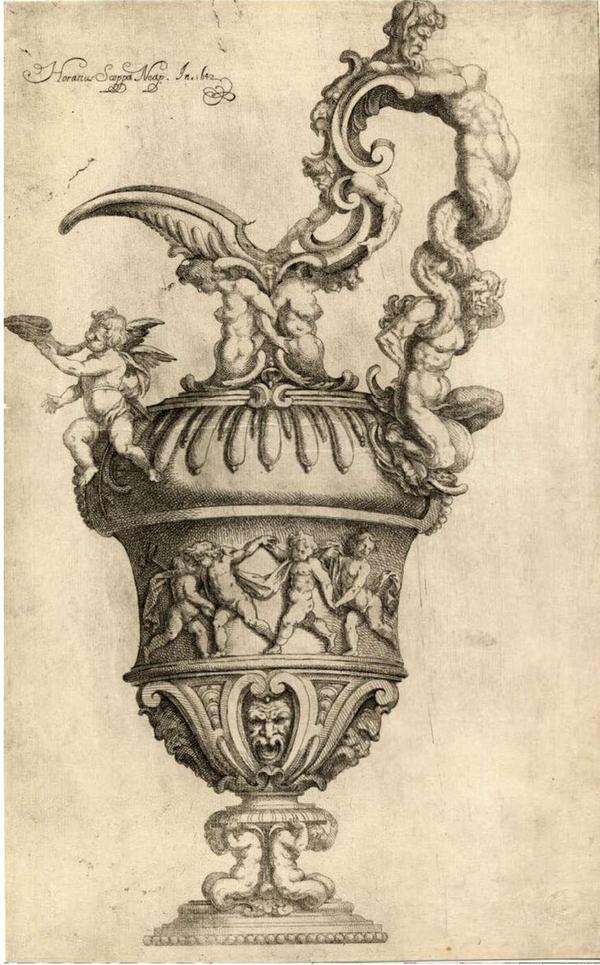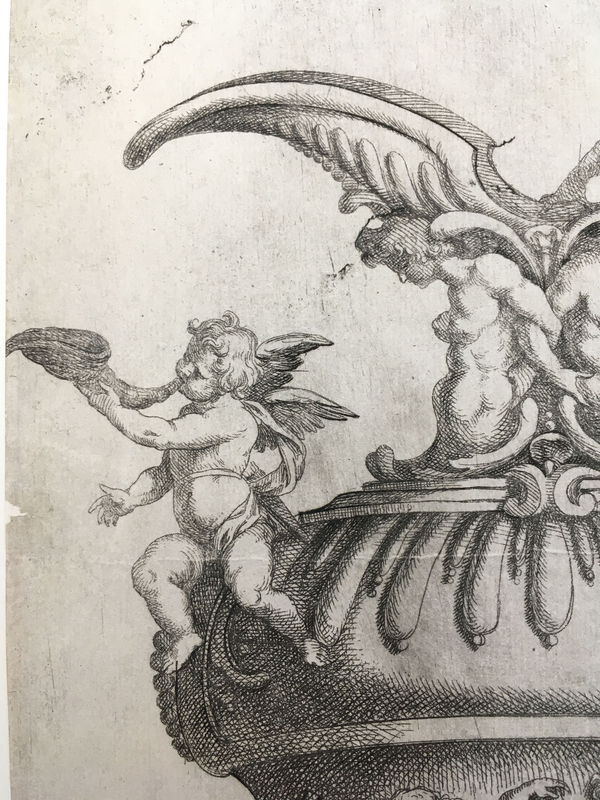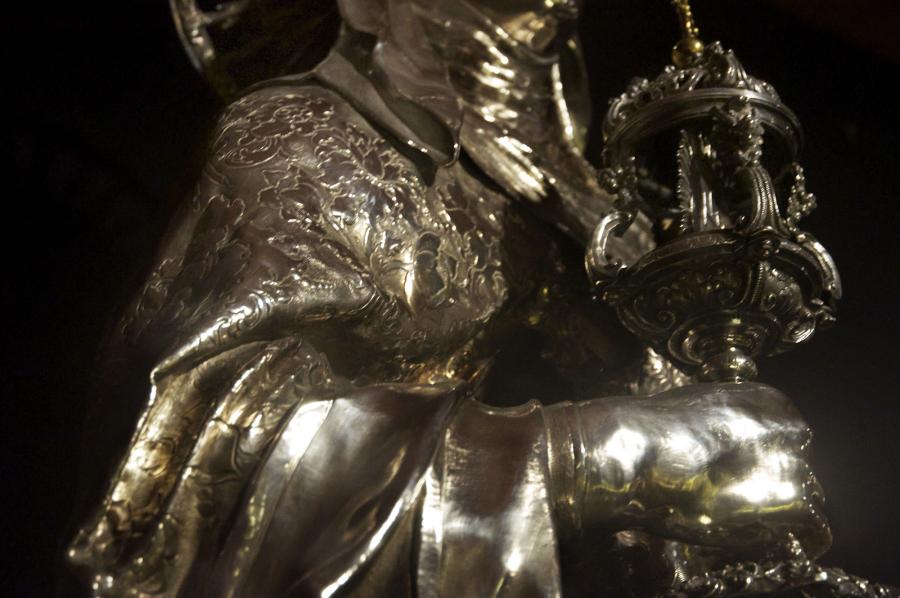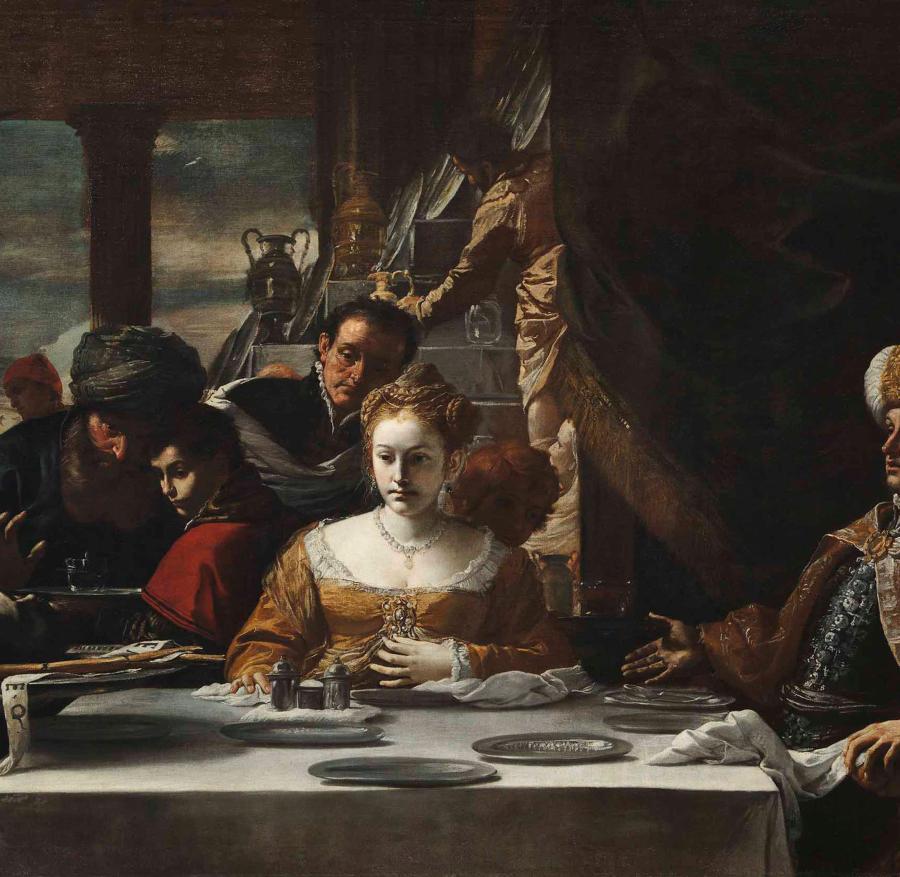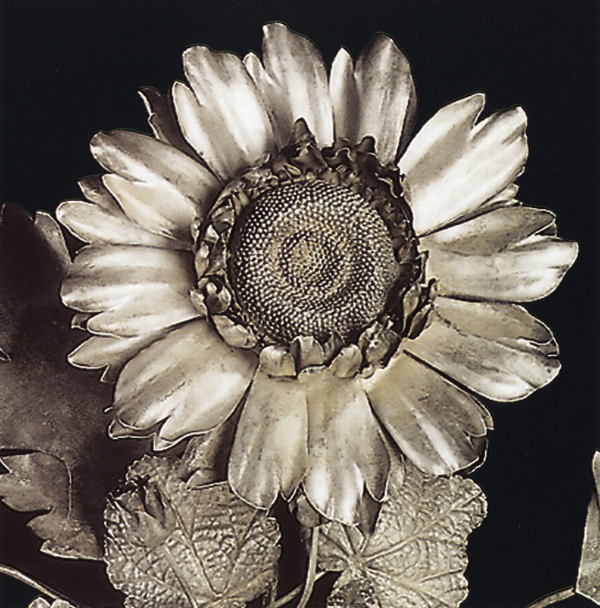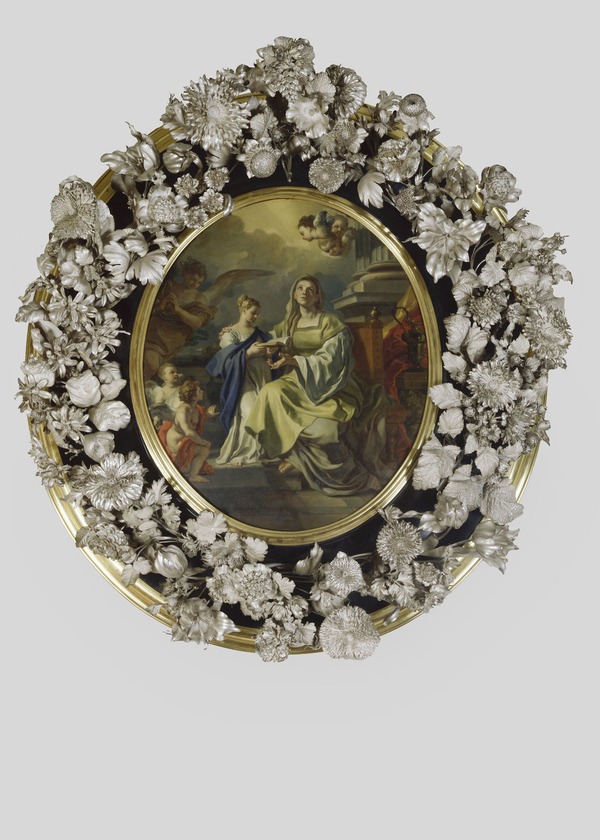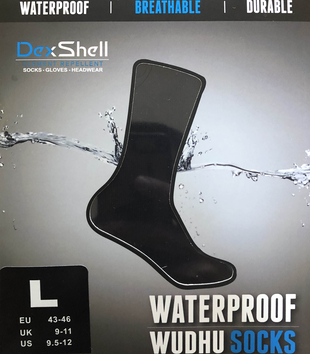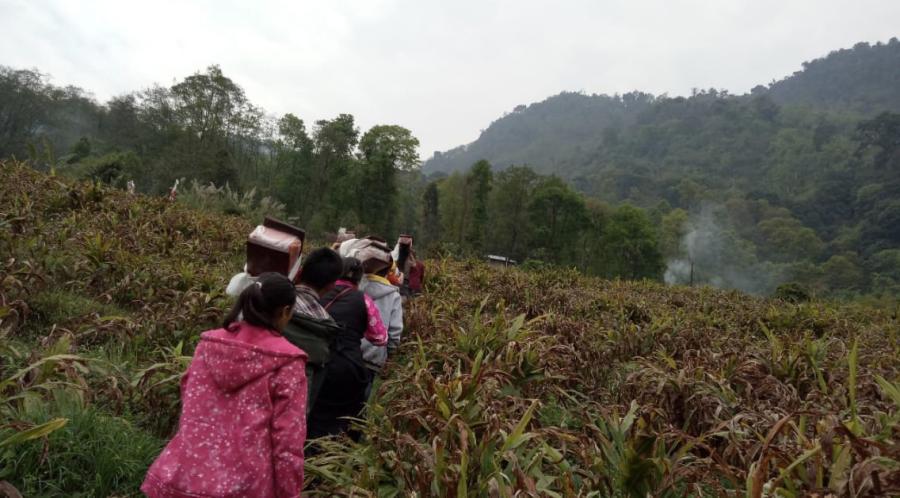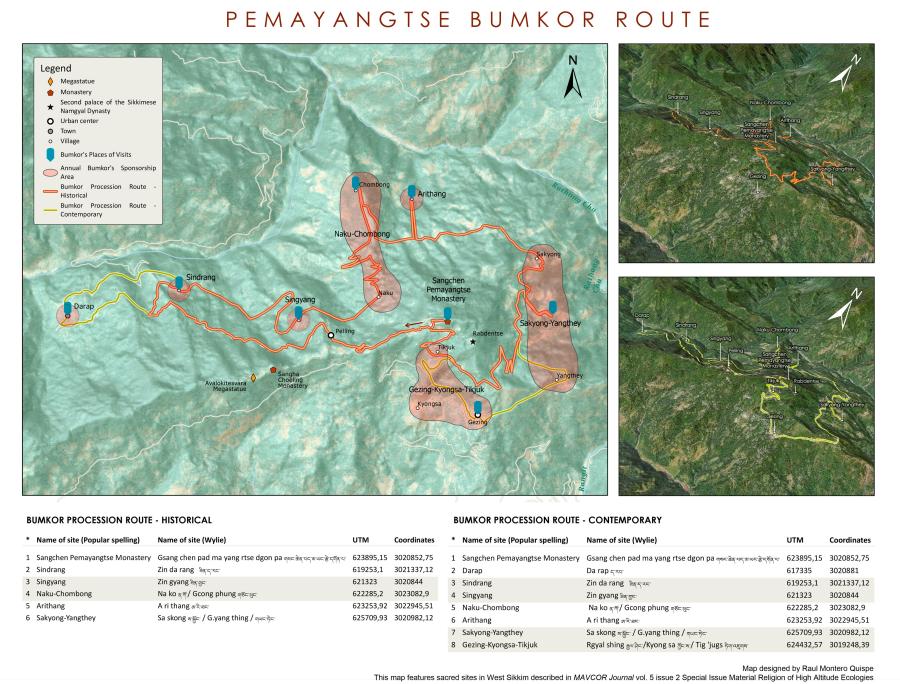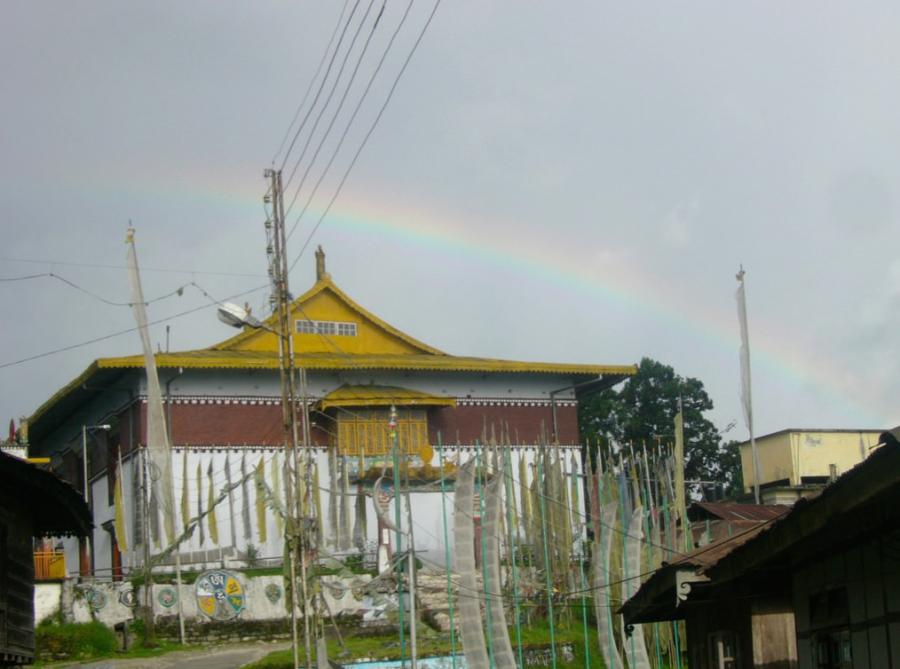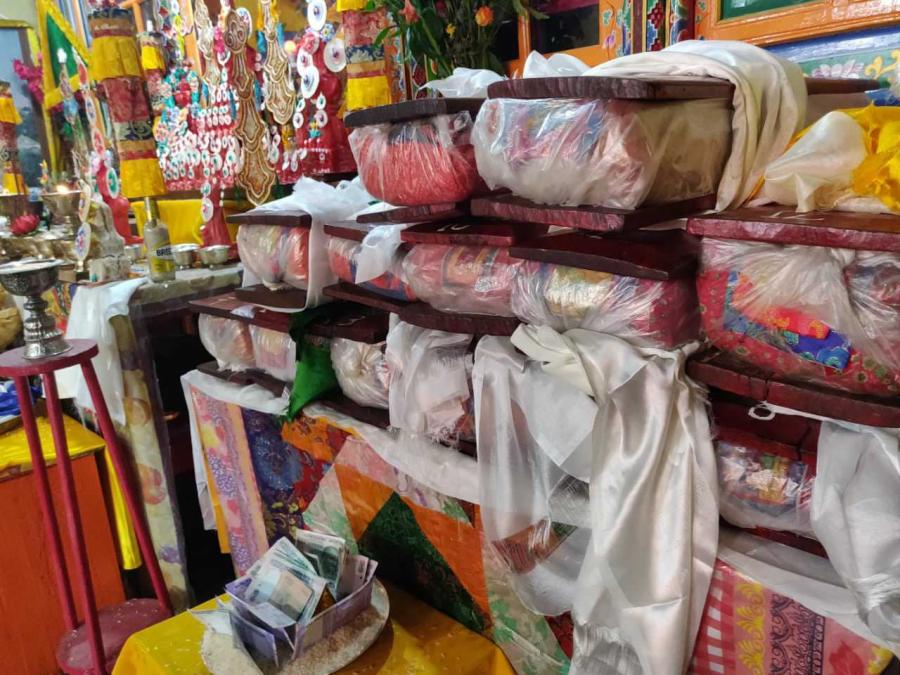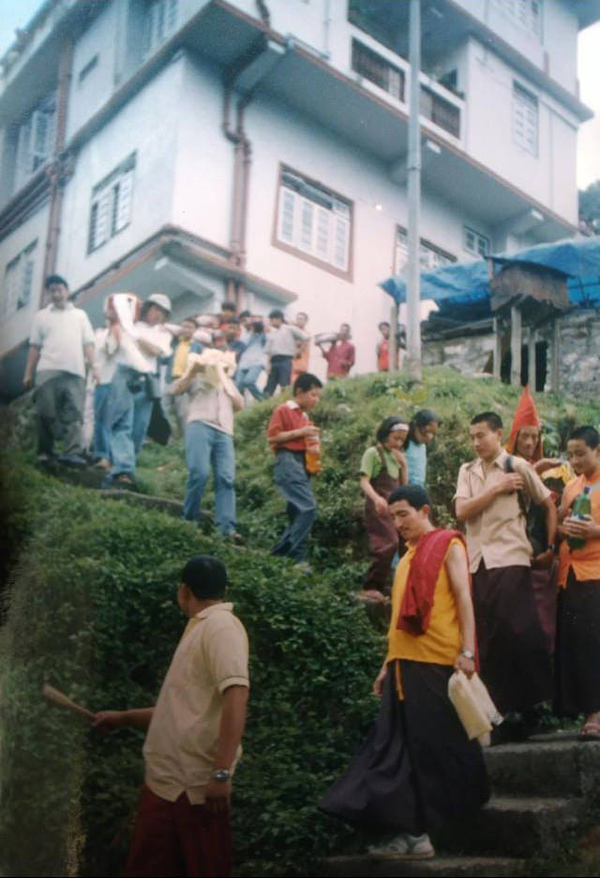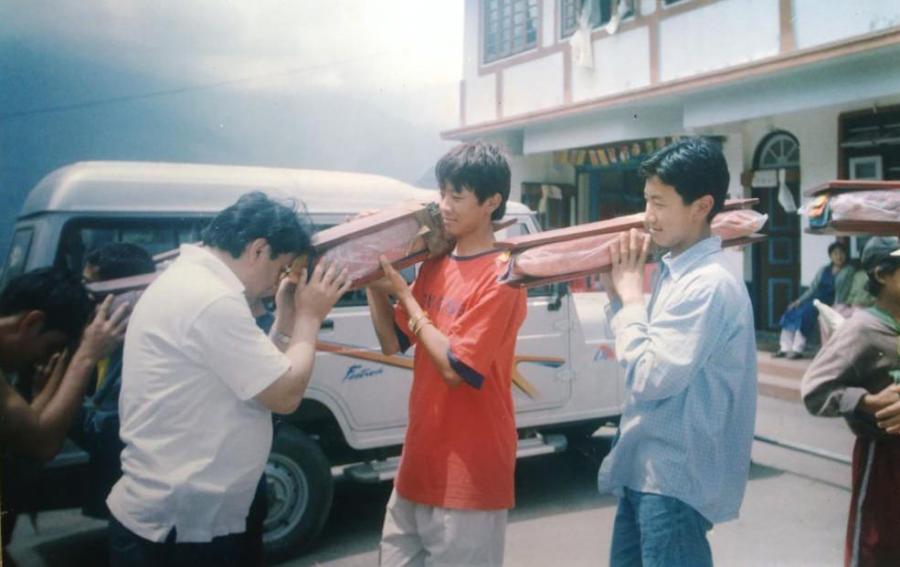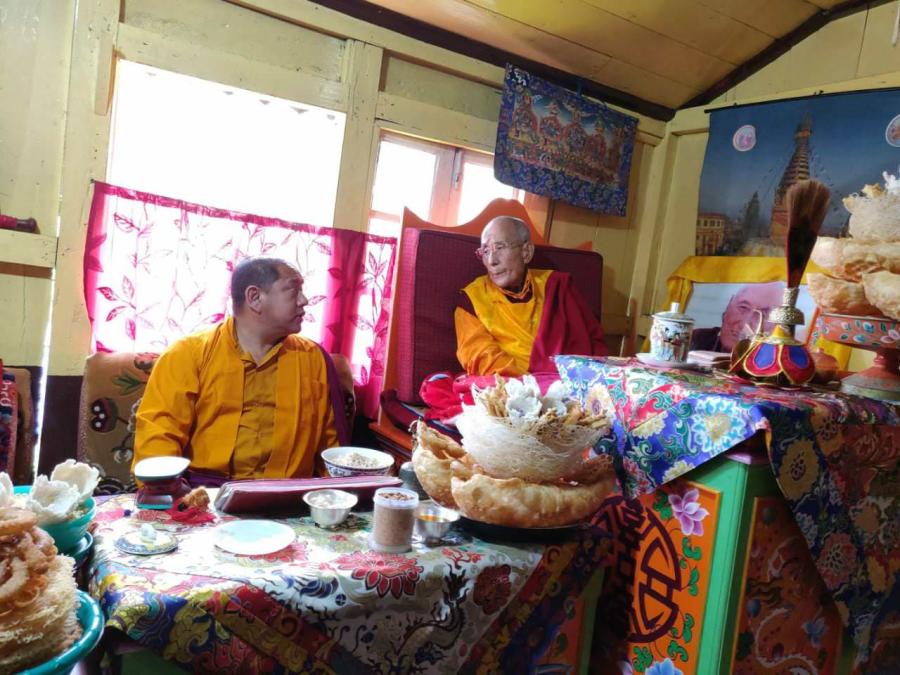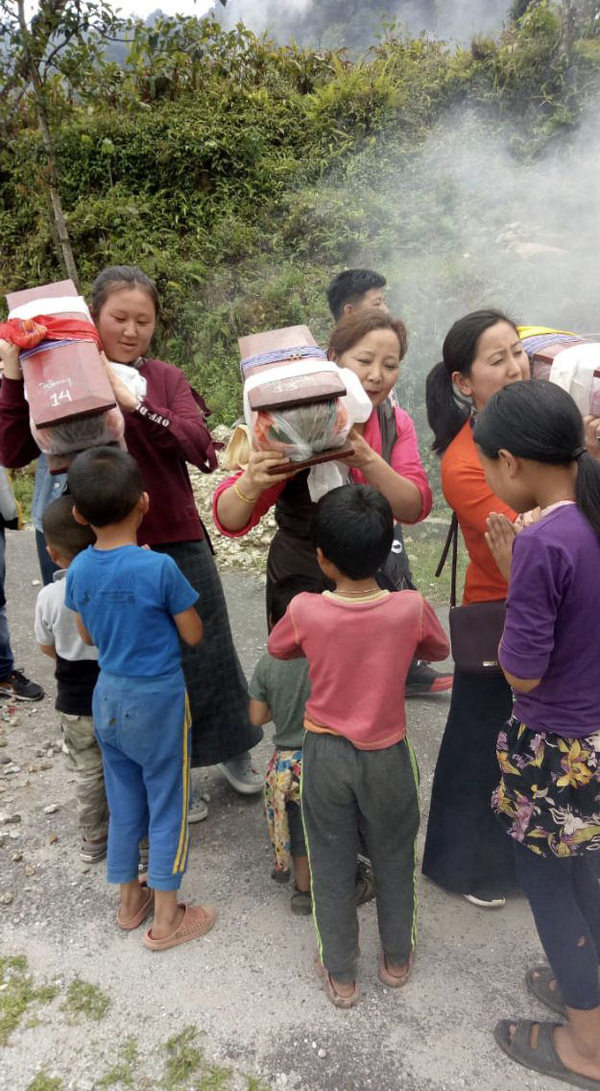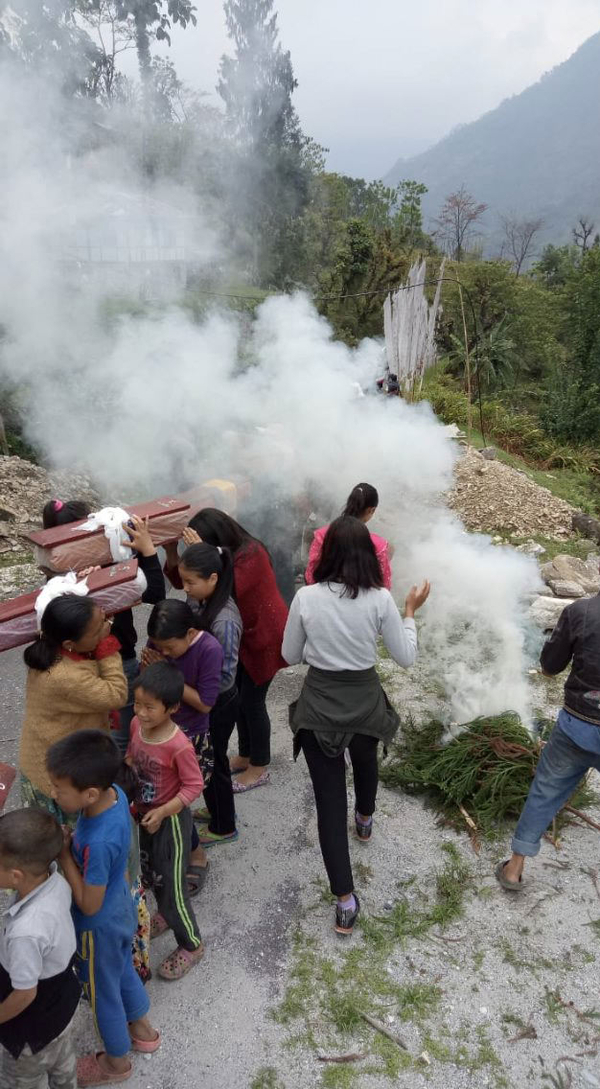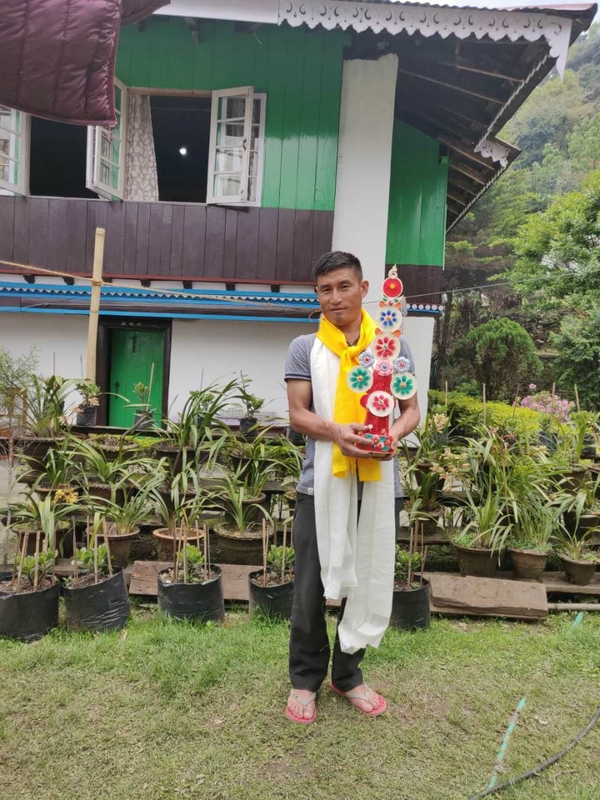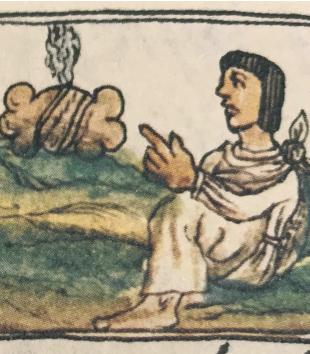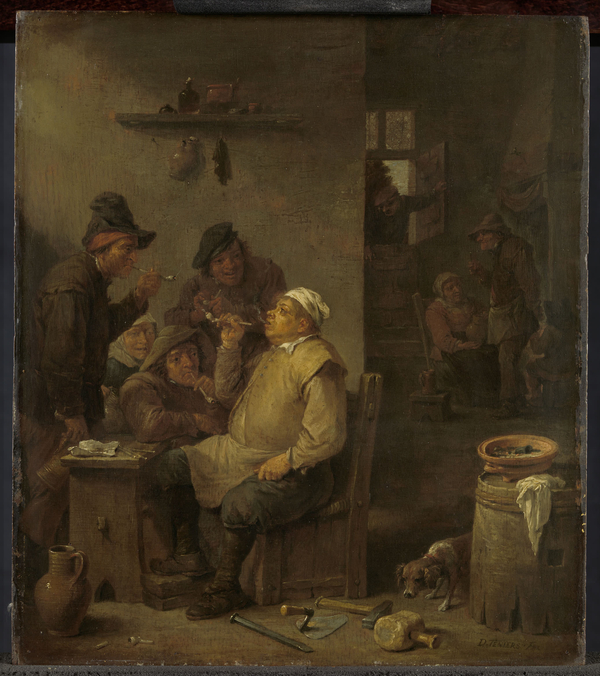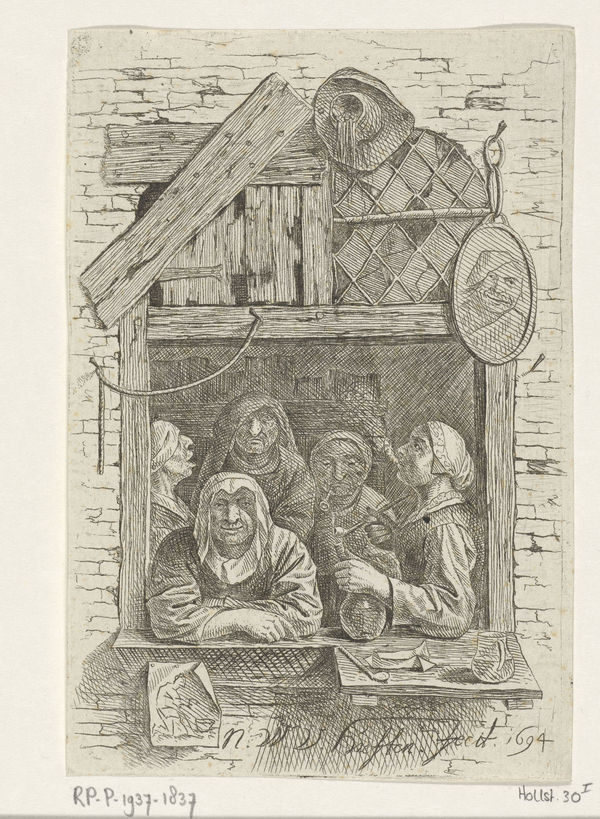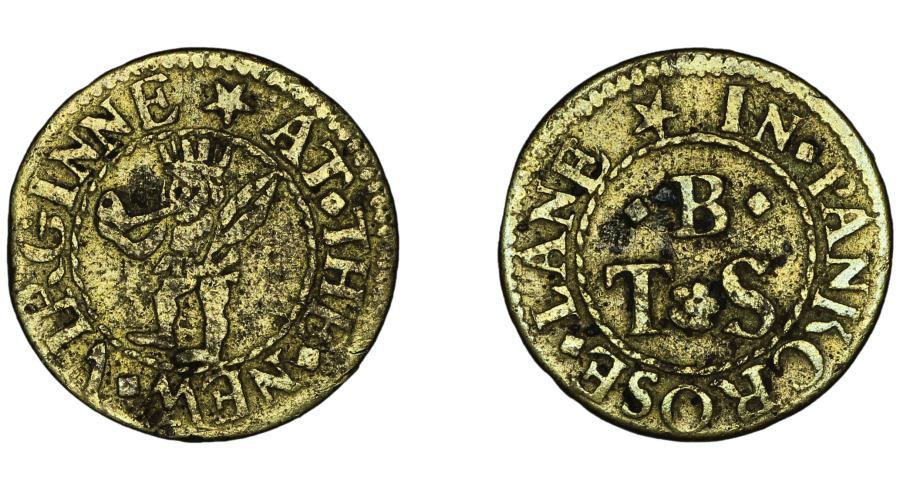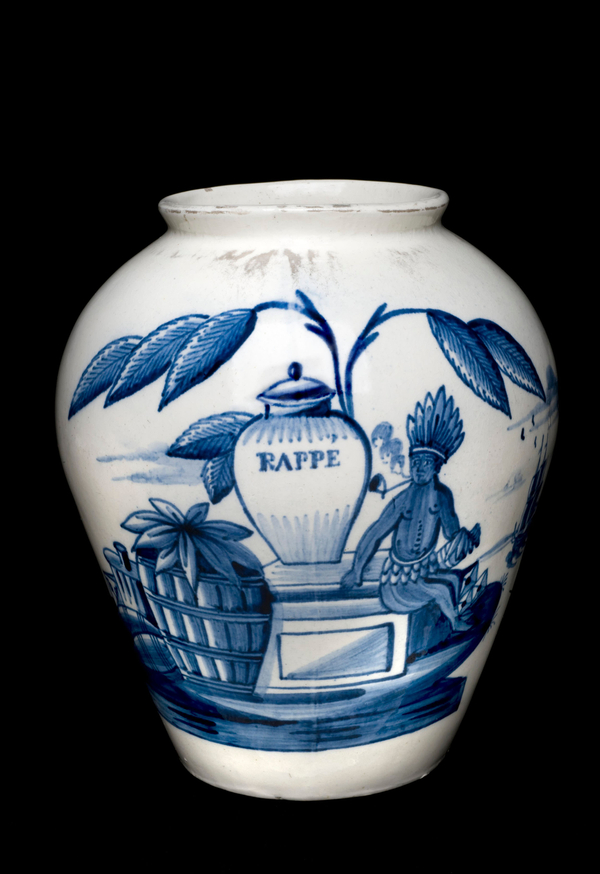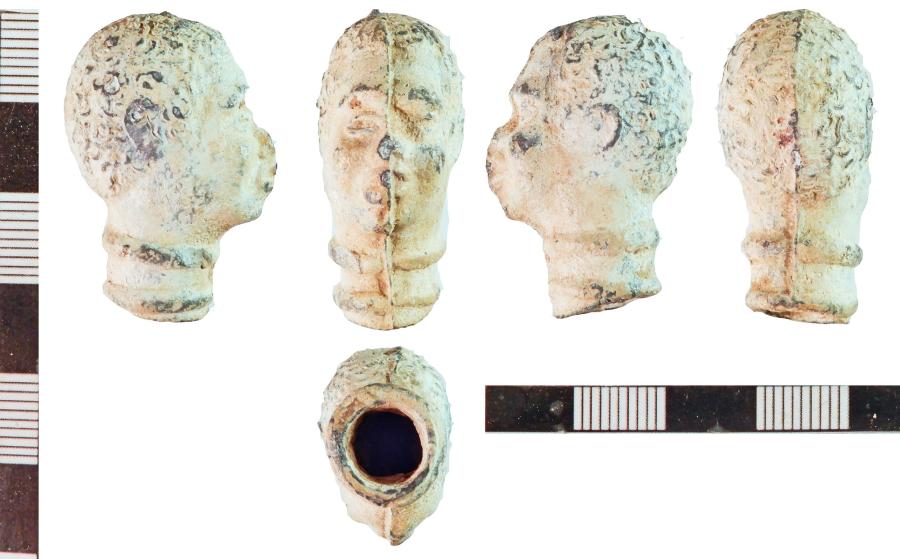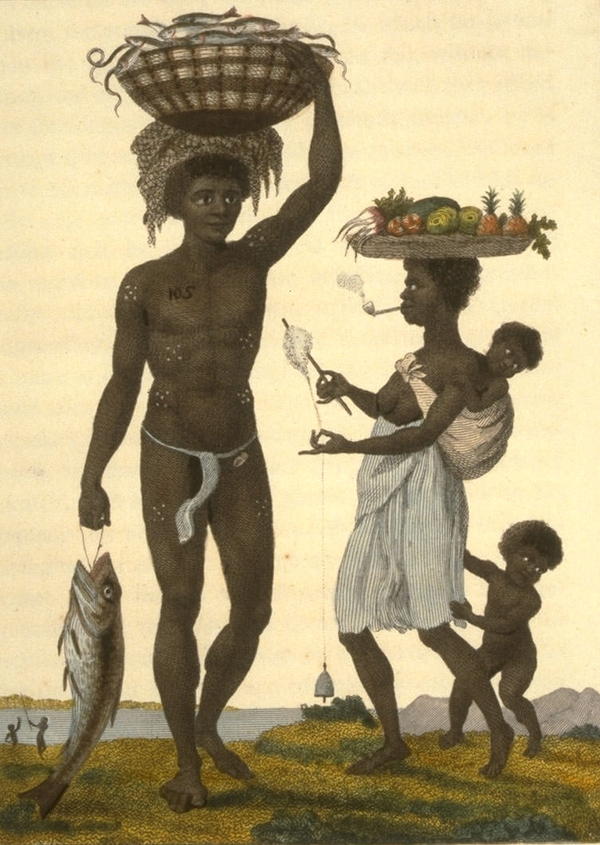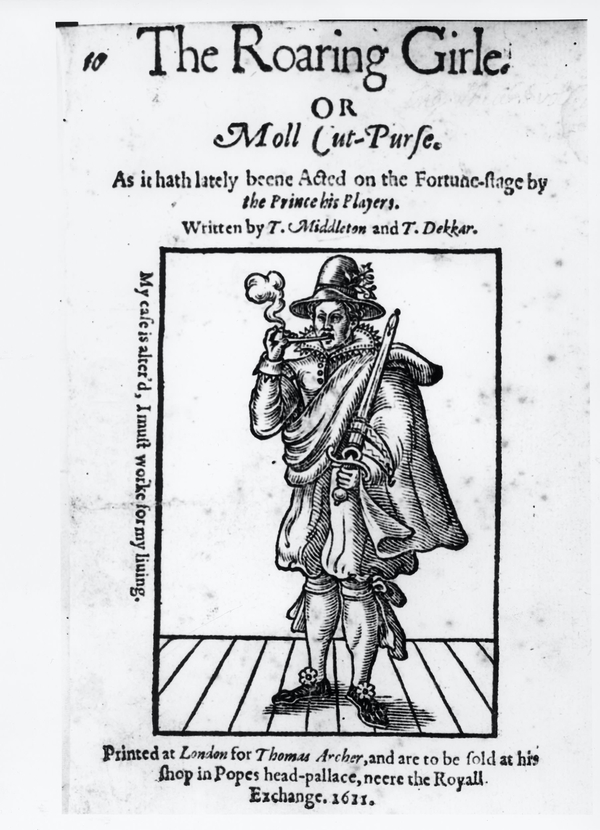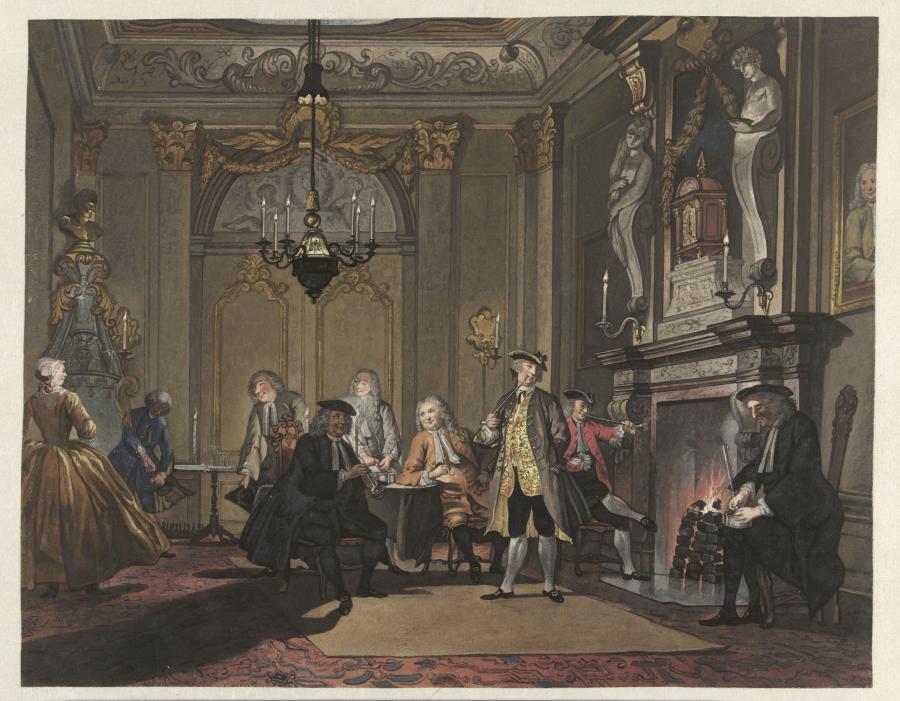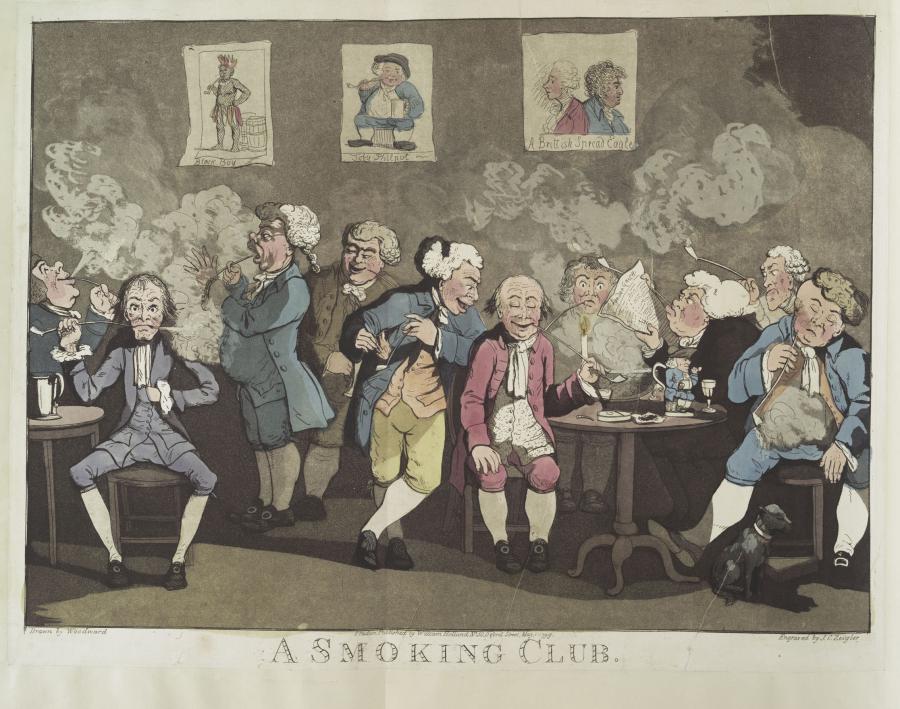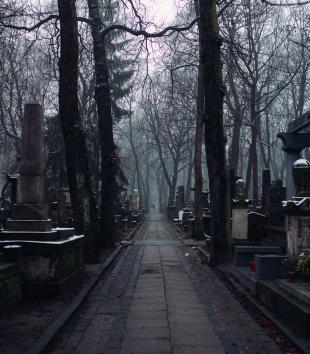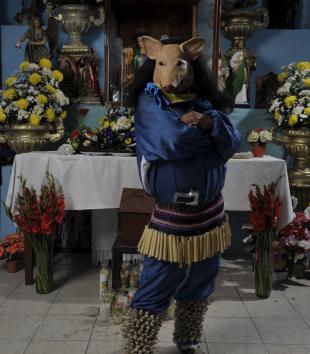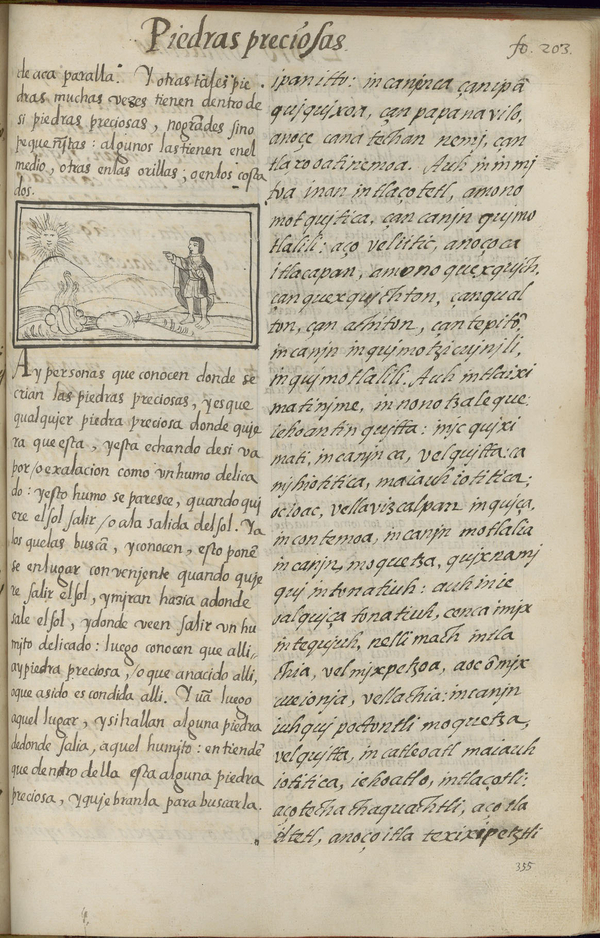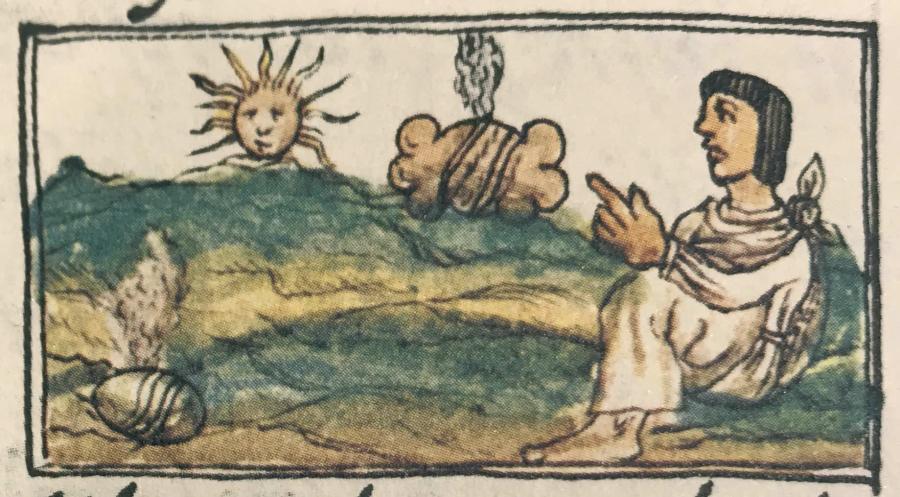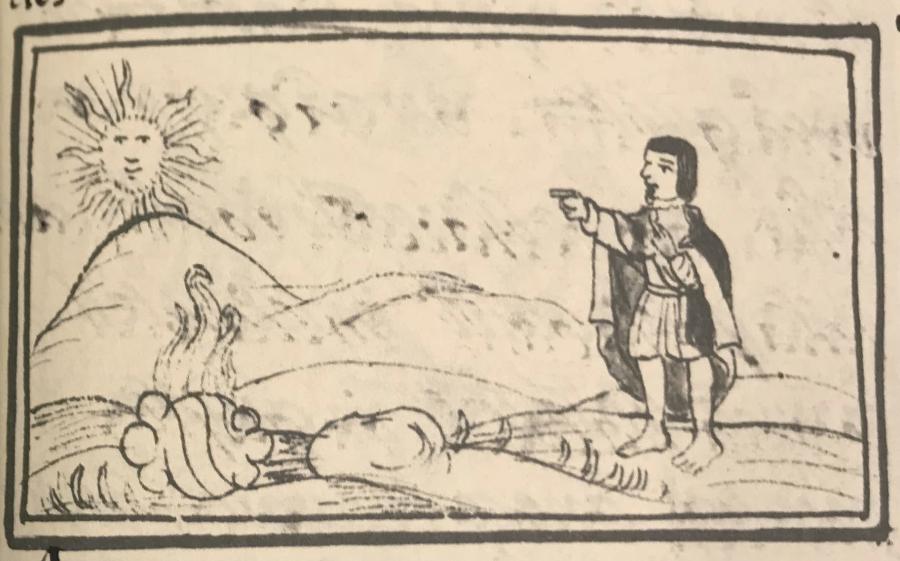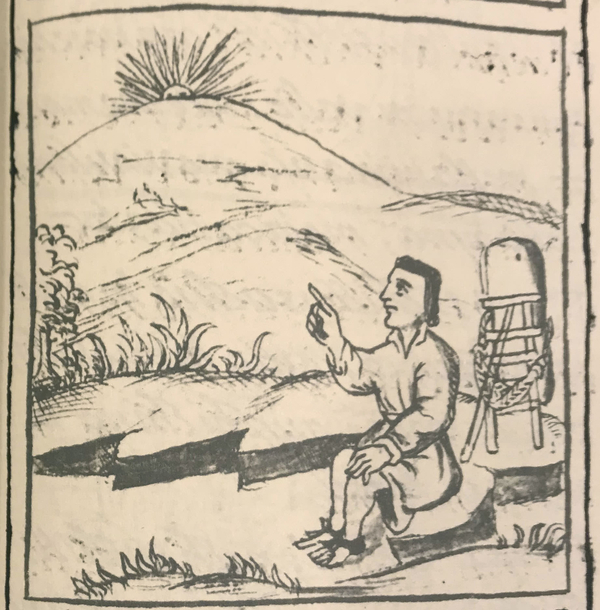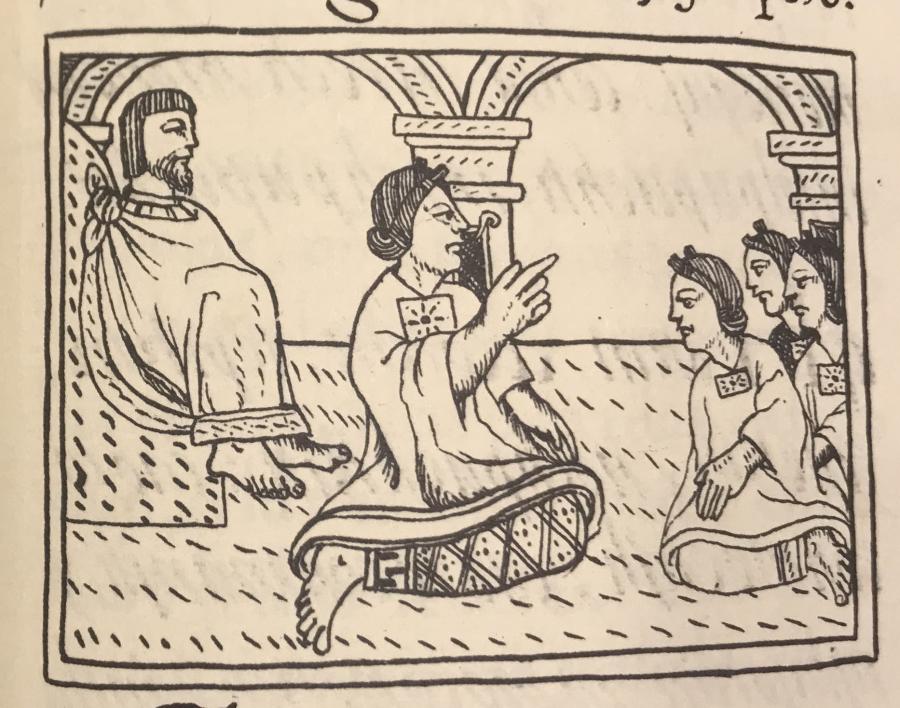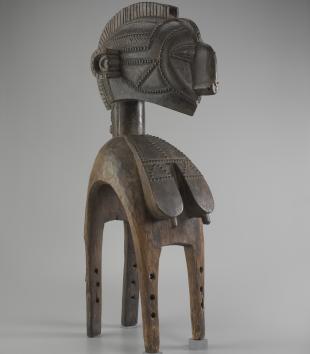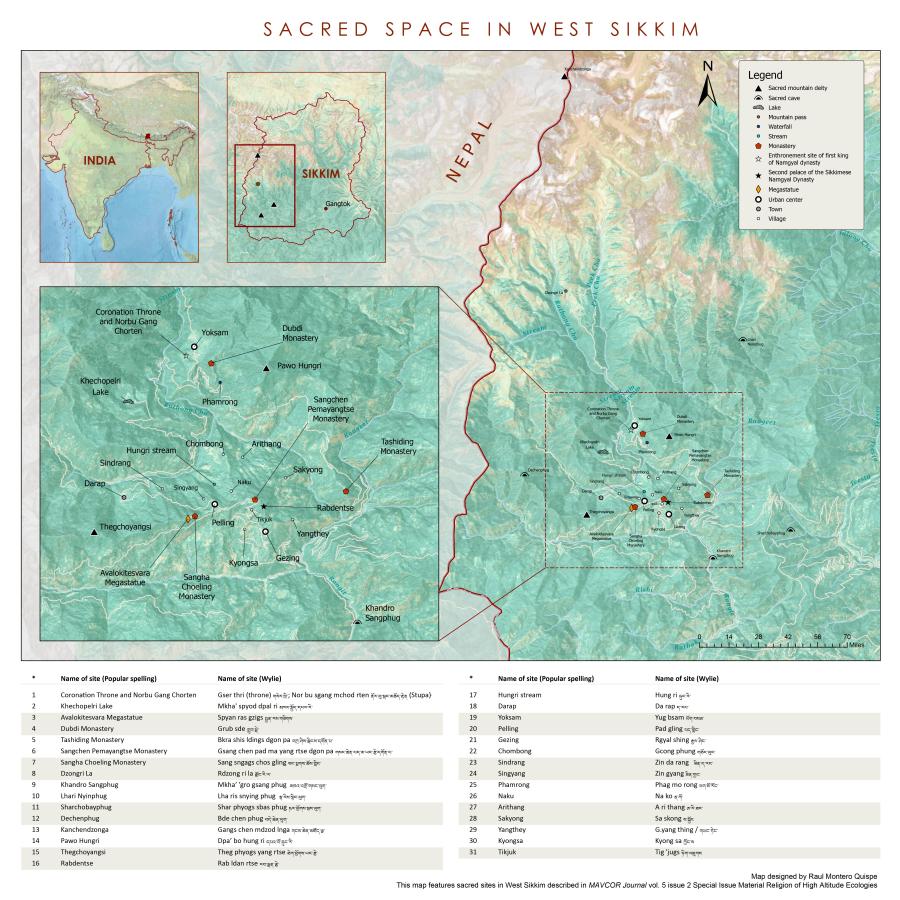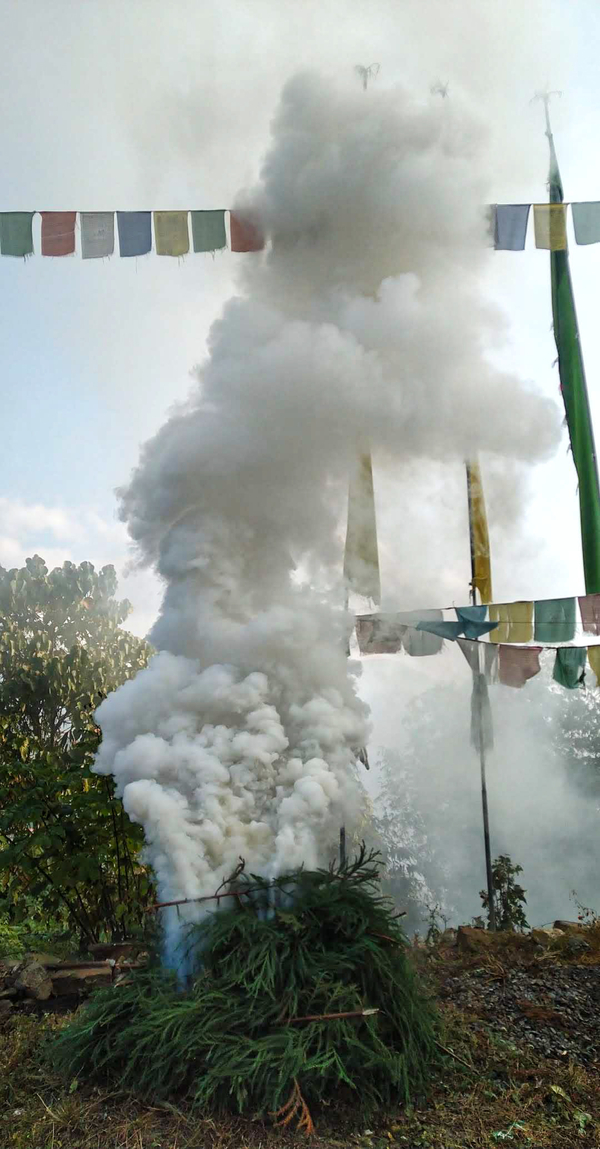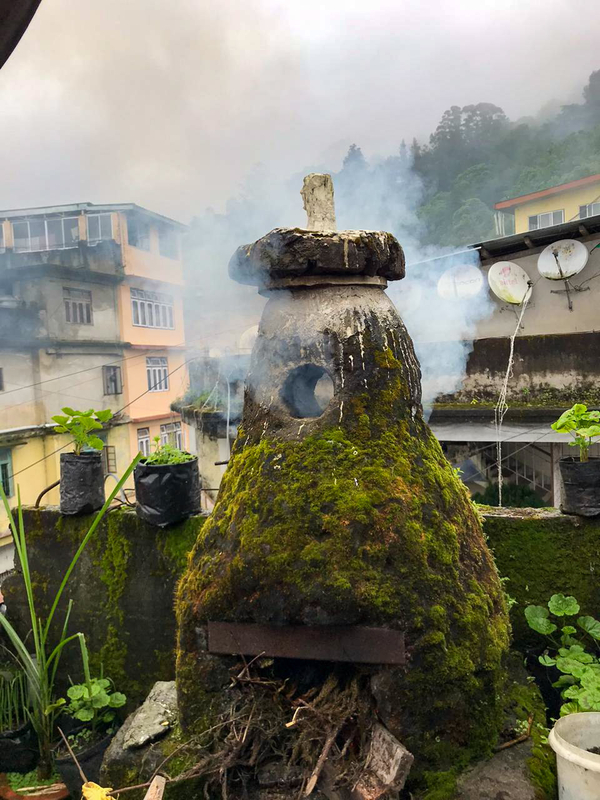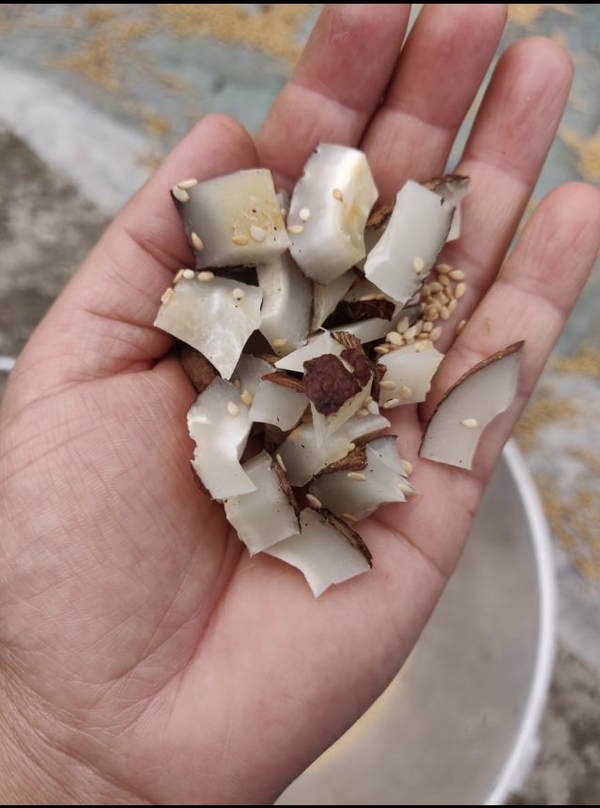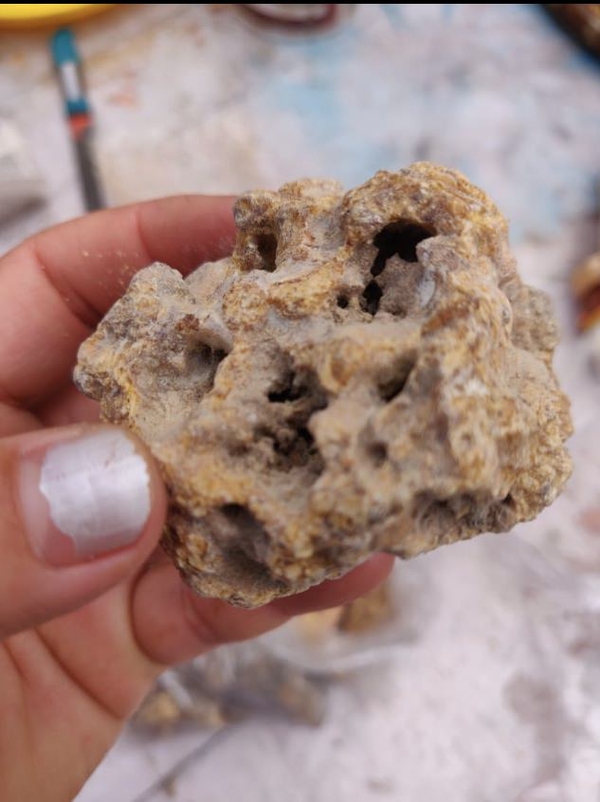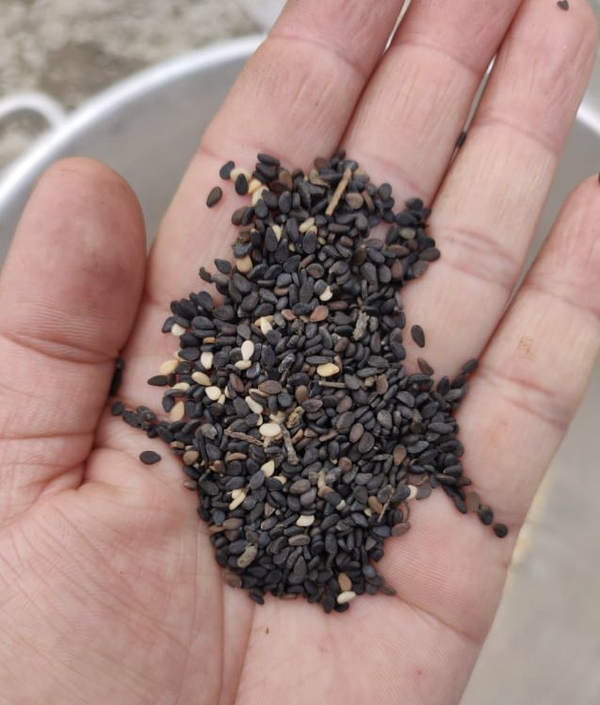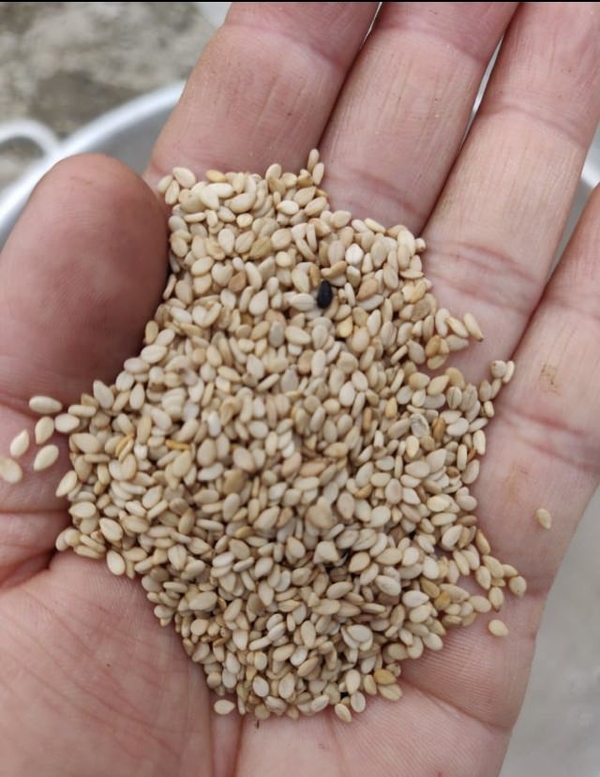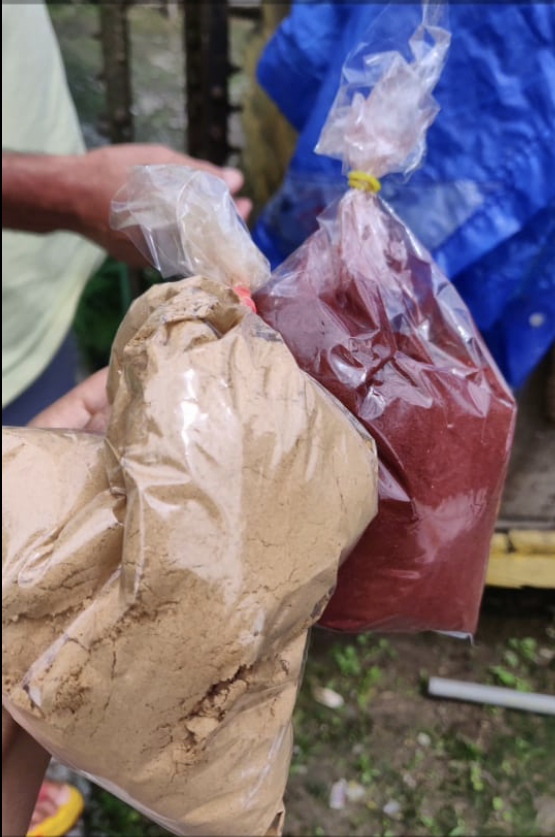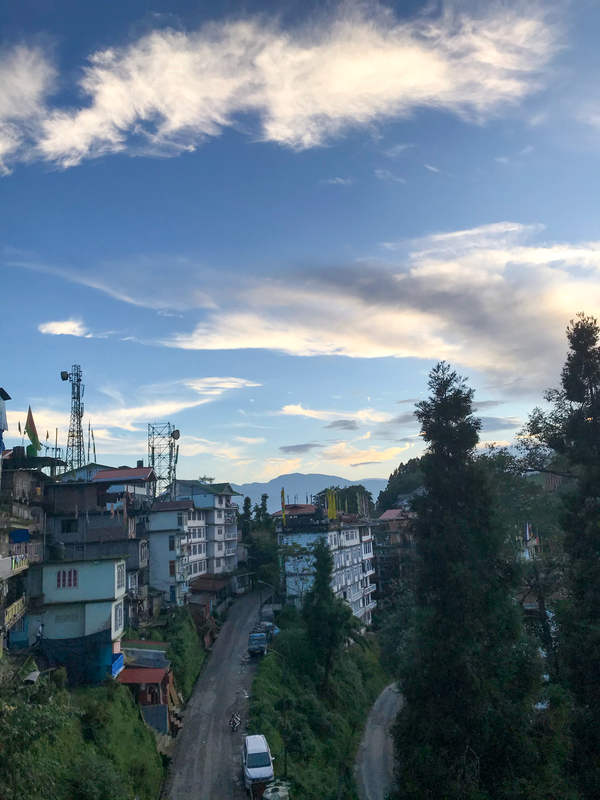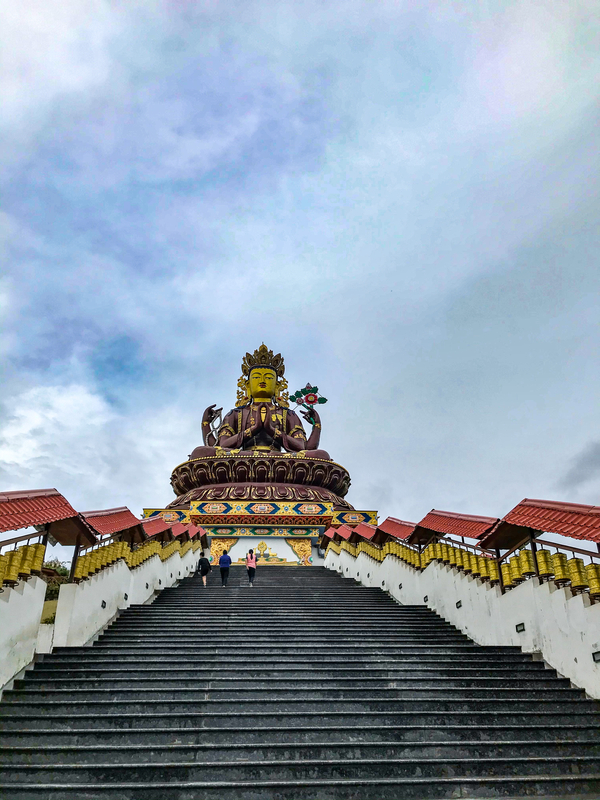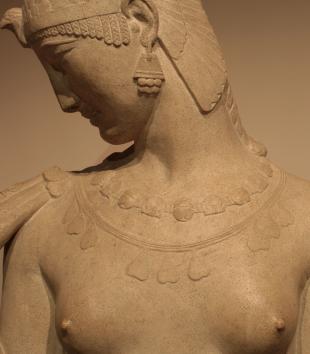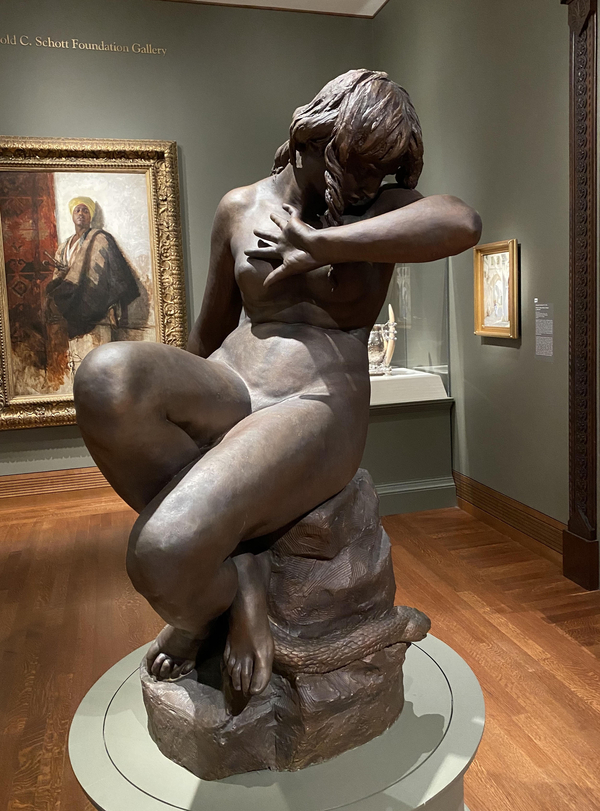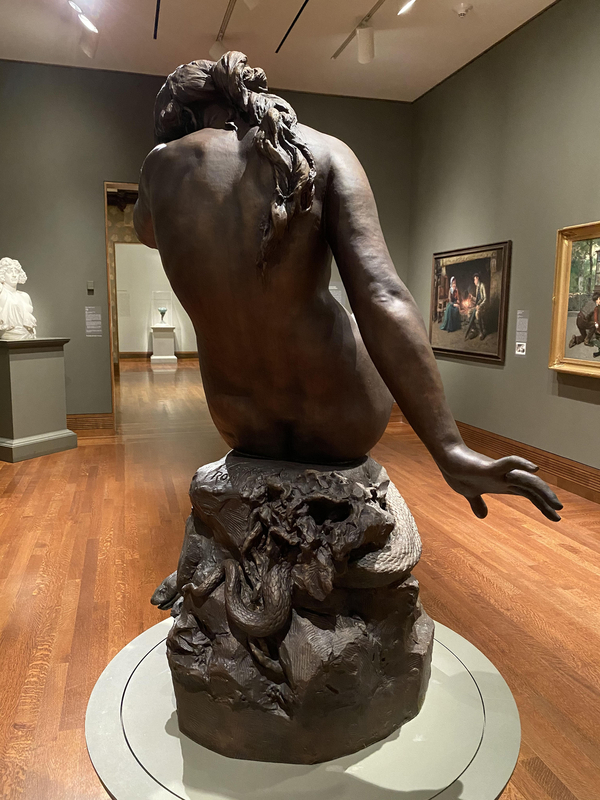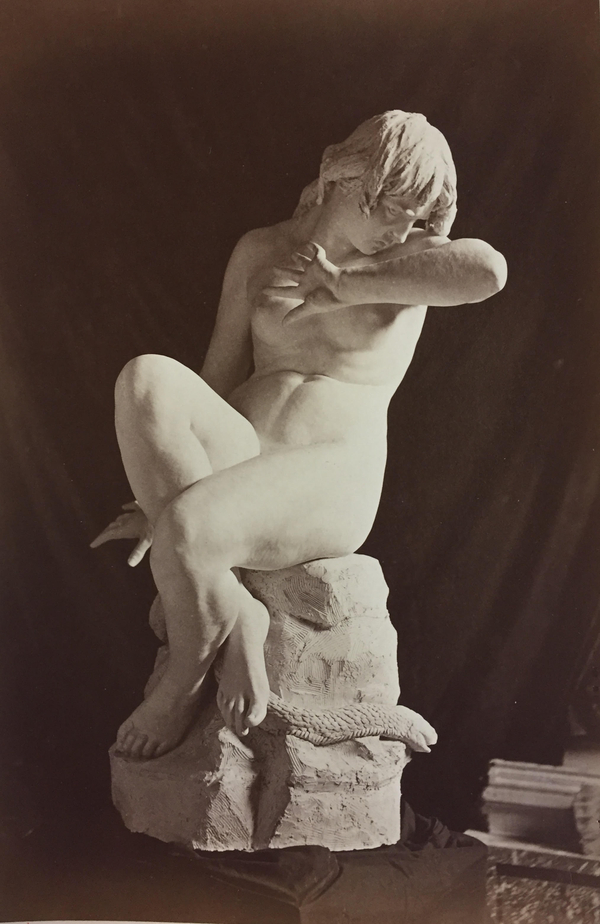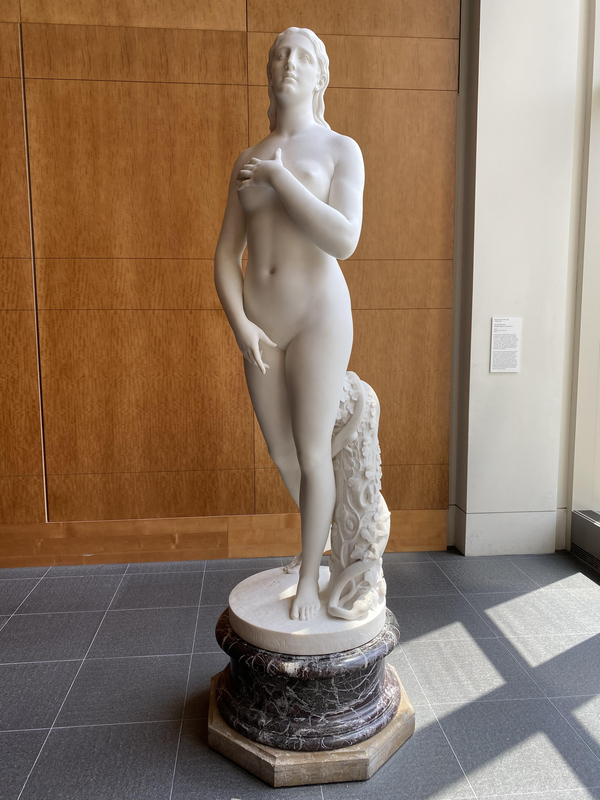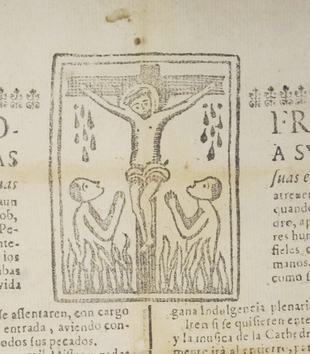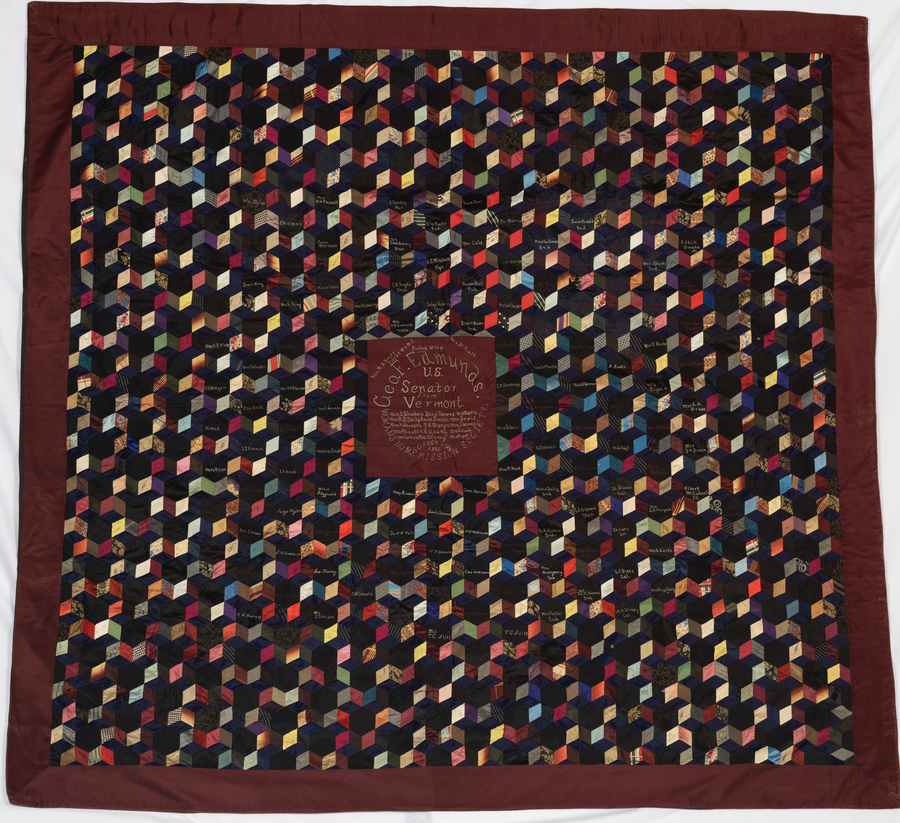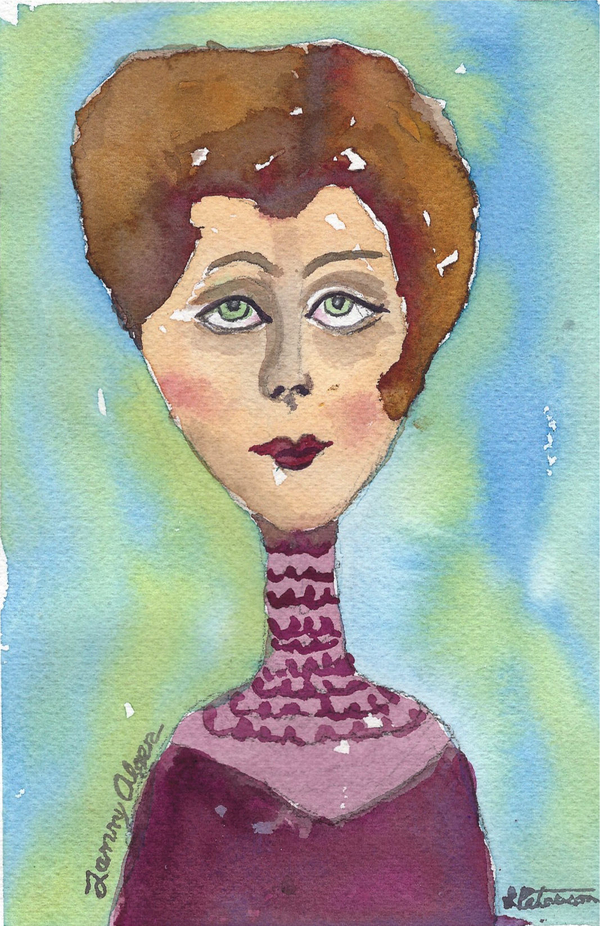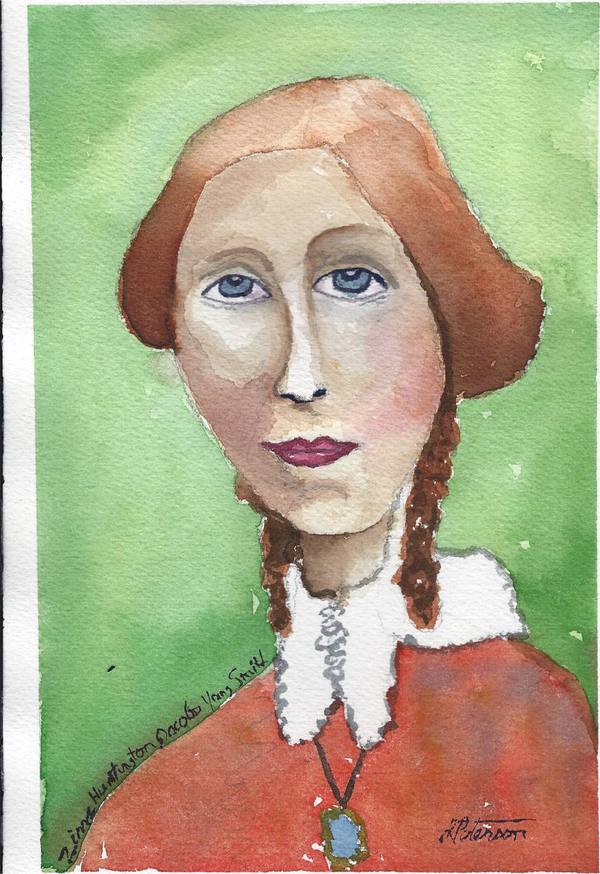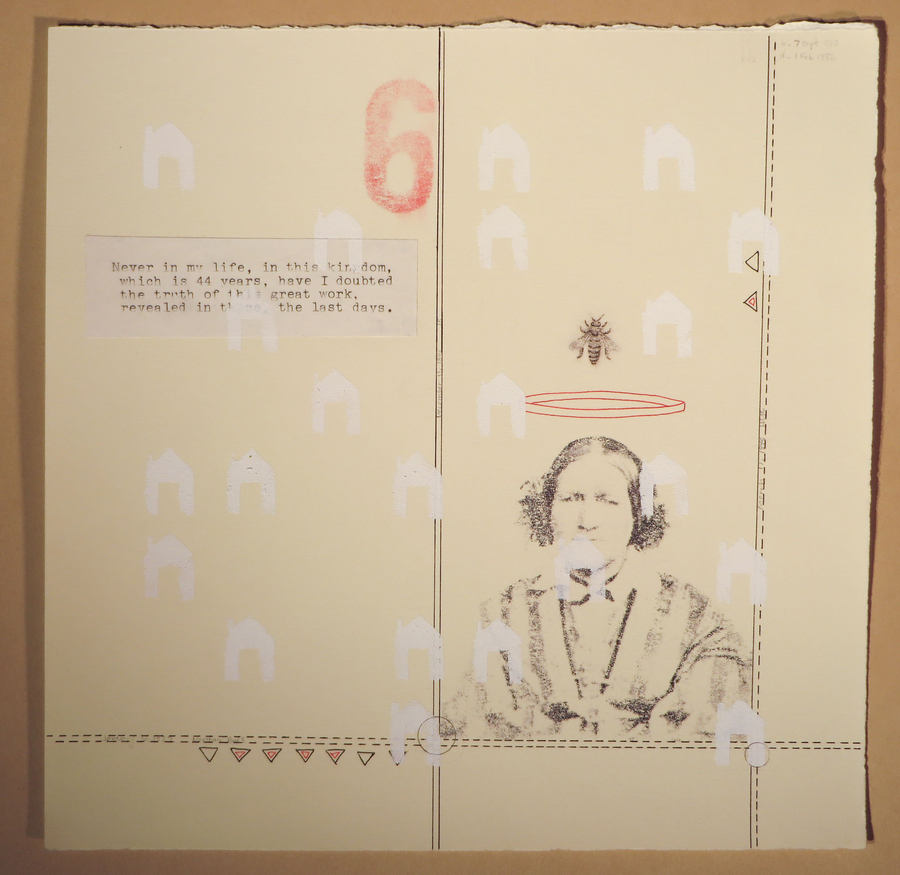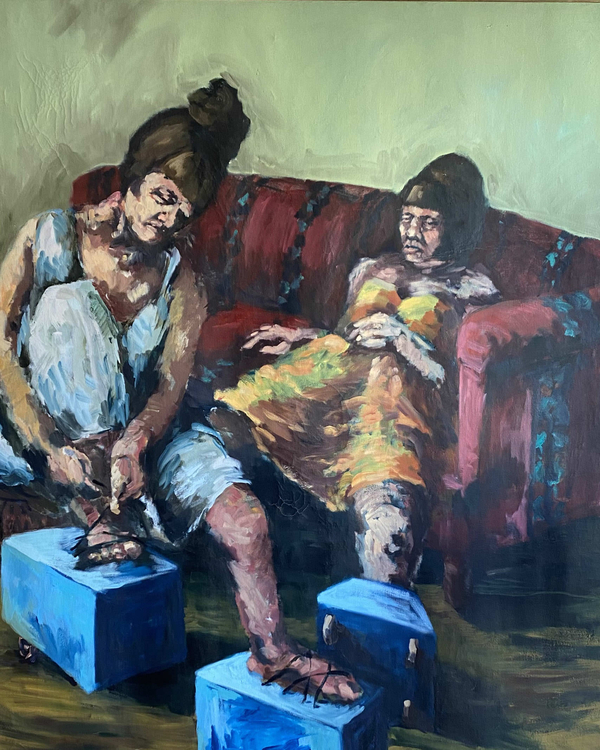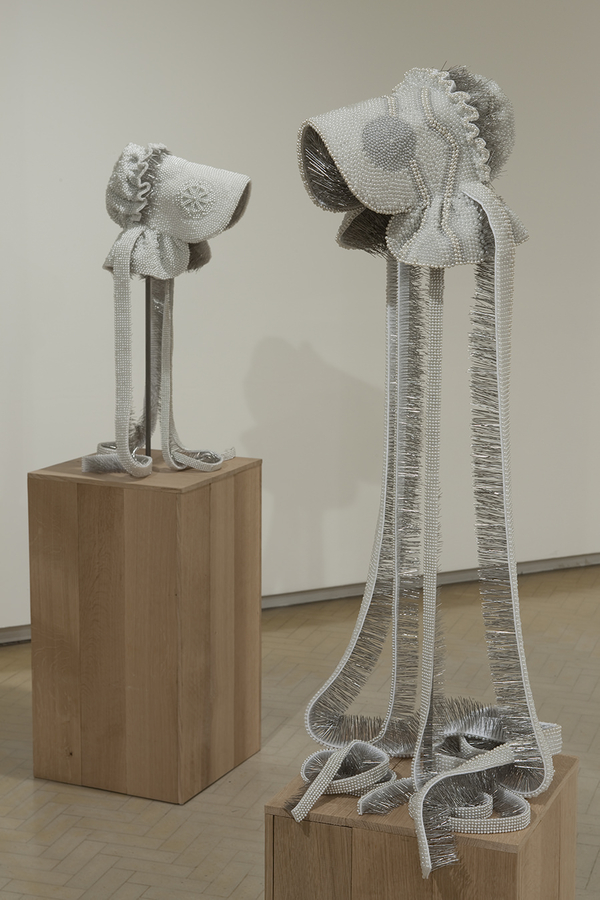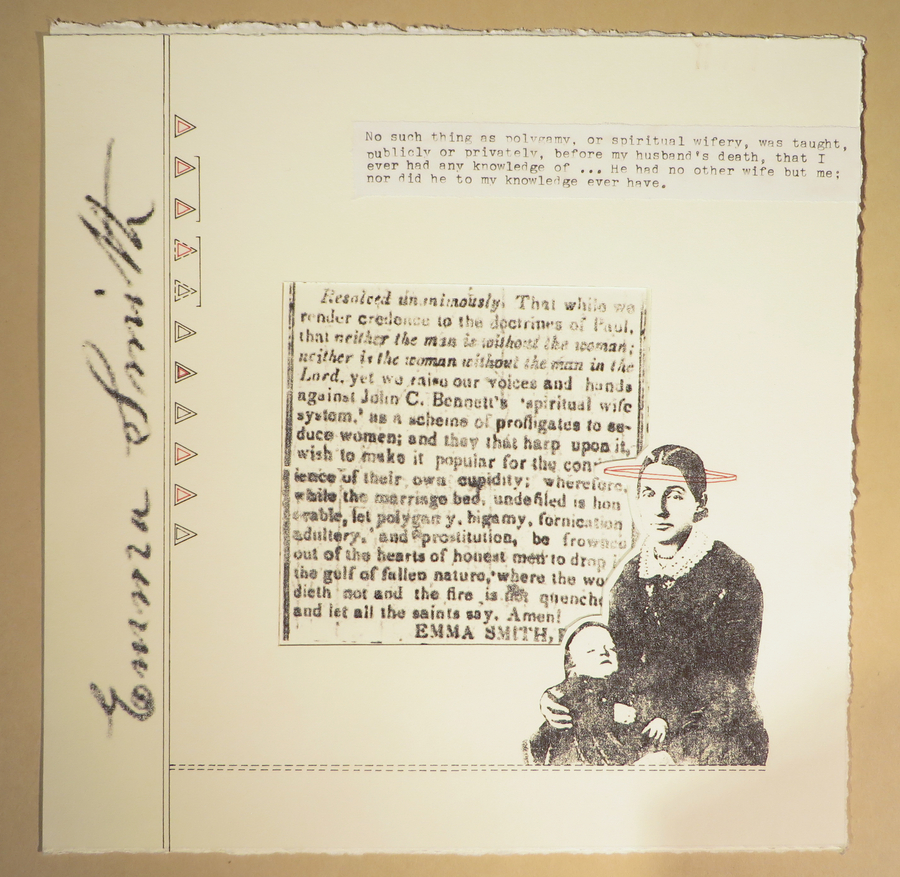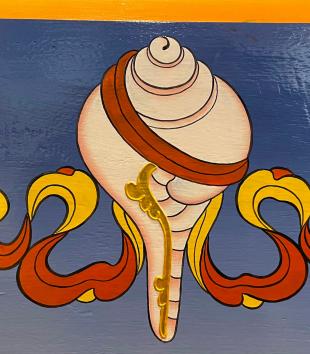The human and sun’s interactions provide a new vantage onto the emissions of breath, smoke, and mist by the precious stones, which typically have been interpreted as an indication of greenstone’s connection to water. Attention to the larger narrative’s interest in socio-sensory contact instead highlights the connection between the stones’ actions and ideas of communication and fame. In both versions of the Florentine Codex passage, the gases emerge from stones that initially are described as either unseen, because they are hidden within a larger stone or the earth, or unrecognized, because of their rough appearance. The Book 11 version explains,
Wherever something like a little smoke stands up, truly they see it, whatever is giving off mist, that is the precious thing. Perhaps it is a spattered stone, perhaps it is a dirty stone, or perhaps it is a polished stone, perhaps a spherical stone: they take it away, they carry it off. And if there is nothing arriving on the surface, there where the little smoke stands, if it is only razed land, thus do they know that where the earth is, that is where the precious thing, the stone, is: then they dig there where they see it, where they discover it.
In the passage, the stones' emissions fundamentally serve to make them visible, both by designating the stones' location and, crucially, by making them recognizable as precious. Both passages primarily refer to the stones in question not as chalchihuitl, or greenstone, but as tlazohtetl, precious stones, a broader category that includes greenstone but exceeds it. The name tlazohtetl derives from tlazohtli, meaning “beloved, precious, rare,” and tetl, stone or any other discrete, solid entity, and includes a wide range of semi-precious stones, a number of which were said to give off various emissions. As a trait of tlazohtetl (precious stones) generally, rather than greenstone specifically, breath, smoke, and vapor betray a close association with the stones’ ability to manifest fame, renown, and social presence. Within this context, the stones’ emissions act not only as a passive sign but as an intentional signal, by which the stones manifest their valued status to those who see and thereby know them. In this sense, the stones’ emissions are cast as an act of self-proclamation, performed in relation to an informed public that can see and interpret the signal. Understood in light of the larger episode and its interest in interpersonal, sensorial relationships, the stones’ emissions are a sensory act that connects the stones to other elements of the landscape, directly paralleling the human and sun’s acts of seeing and shining. Through their act, the stones emerge into a sphere shared with the human and sun and gain social recognition as stones of value.
The stones are said in both versions to release breath, moisture, smoke, and mist at the exact moment of the sun’s rising, coinciding with the human’s act of seeing. The description may have an empirical basis in the tendency of certain materials, referred to as hygroscopic, to maintain moisture equilibrium with the relative humidity of the surrounding air. In an environment like the one described, these materials absorb moisture at night, when relative humidity is high, and release it in the form of vapor at sunrise, when the relative humidity drops. Through this process, materials respond to diurnal cycles of the rise and fall of relative humidity, cyclically absorbing and releasing humidity in the form of water vapor. Examples of hygroscopic materials include organics like wood and paper, as well as inorganics like salt. Jadeite, an aggregate crystalline material, is another likely candidate for this type of responsivity to ambient humidity.
Providing a further layer of interpretation, the specific Nahuatl terms used to characterize these emissions underscore their social valences and point to an understanding that, by emitting gases, precious stones were presenting themselves to a knowing public. The two versions describe the stones’ emissions as follows: “mjhiotitica” (“it is giving out breath”), “tlacuechaoatica” (“it is getting moist”), “poctontli, aiauhtontli moquetzticac” (“a little smoke, a little mist stands up in place”), and “popocatica” (“it is smoking”). Collectively, these terms describe specific types of emissions: breath (ihiyotl), smoke (poctli), and water vapor (ayahuitl). The first term, mihiyotitica (it is giving out breath), provides a general description of the phenomenon of an entity’s partial sublimation into its surroundings, allowing it to aquire an overtly sensible and agentive quality. The second two terms provide a more specific charactization of the emissions as poctli (smoke) and ayahuitl (water vapor). Together, these terms form a rhetorical pair, known as a difrasismo, that refers to one’s manifestation before a viewing public. As will be seen, these terms collectively interpret the stone’s emissions as transforming aspects of its materiality into a perceptible, social presence.
The first term, ihiyotl, describes the stones’ breath as a sensorial emission that emerges from a body into surrounding space. The term is known mainly from its application to humans, where it named an animating force, conceived of as a gaseous entity that resided in the liver. Jill Furst describes the human ihiyotl as multisensory, characterized by both smell and glow, and able to emerge from the body as living breath and, upon death, as nebulous gas. Usage of ihiyotl in other contexts provides a fuller sense of this term and its applicability to a broader range of observable emissions. In his definition of ihiyotia, to cause or make ihiyotl, Molina glosses the term as, “resollar, o peerse, o tomar aliento o resplandecer y luzir con ricas vestiduras” (“to breathe heavily, to pass gas, to breathe, or for rich apparel to gleam and shine”). Complicating an anthropocentric understanding of ihiyotl, Molina’s reference to emissions of light from “ricas vestiduras” (rich apparel) suggests that the term names not only gaseous emissions from the human body, but also other strongly sensorial emissions. This interpretation is also suggested by the definition of the verb in its reflexive form, mihiyotia, "to make ihiyotl for oneself," used in the main Florentine Codex passage to describe the stone “giving off breath” (mihiyotitica). Molina defines mihiyotia as, “echar de si resplandor, o proceder grã frio dela nieue, o gran ardor o dela llaga” (“to give off resplendence, or for great cold to come from the snow, or a burning sensation from a wound”). This gloss evokes emissions of brilliance, cold, or burning, all of which are unified by their connection to sensory experience, with their specific traits derived from the nature of the body from which they emerge. In this way, cold emerges as the ihiyotl of snow and burning as that of a wound. These definitions portray ihiyotl as an incorporeal yet sensorial entity that expresses the nature of the body from which it emerges and enables that entity to be experienced.
In addition to carrying sensory information, the ihiyotl was also closely tied to communication—especially speech—and to action in the outside world. Ihiyotl’s connection to speech is seen in its use in the phrase, ihiyotl, tlahtolli (“breath, words”), a metaphor for fine speech. Its communicative and interactive nature is underscored further by its use in the term tlaihiyoana, “to take things with the breath,” a frequent attribute of precious stones. The term is formed from tla-, the non-specific impersonal object prefix; ihiyo(tl), “breath”; and ana, “to take hold of, seize,” with the resultant meaning, “to take hold of things using the breath.” This term appears in Book 11 of the Florentine Codex as an attribute of the greenstone quetzalitztli (“quetzal-obsidian”), which is said to be “mjtonjanj tlaihioananj” (“one that sweats, a taker of things with its breath”). This usage suggests that, in addition to an incorporeal entity that elicited sensory experience, ihiyotl could be used to act in one’s surroundings. In this way, tlaihiyoana (to take with the breath) was used to describe certain animals’ technique of hunting by drawing unwilling creatures to themselves with the breath. The Florentine Codex states of the tlilcoatl, or black snake:
Auh in aca çan qujpantilia: in aço vmpa aci, in oncan canjn onoc tlilcooatl: injc vel cana achtopa qujztlacmjna, in iehoatl tlilcooatl … njmā qujhiioana, yioma ivicpa iauh in tequanj; mochichicanauhtiuh, chichicoieoatiuh, iuhqujn tlaoanquj icamac calaquj in tequanj…
If someone just comes upon or arrives there, where the black snake is lying, because of this, right there, the black snake strikes first … Then it siezes him with the breath [ihiyotl], and, oh!, towards the wild creature he goes: he goes being taken and proceding while weaving side-to-side, and, like a drunkard, enters into the mouth of the wild beast…
In this usage, the ihiyotl, by virtue of its ability to emerge from the body and make contact with external entities, physically draws them into the body from which it emerged. A related dimension of the ihiyotl appears in the statement that the ocelotl tlatlauhqui (“red jaguar”) “mjpotza injc ihiiotica qujçotlaoaz, qujiolmjctiz, in tlamjnqui” (“belches, so that by means of its breath [ihiyotl] it will make the hunter faint and pass out”). Though, in their translation, Anderson and Dibble render ipotza as “hiss,” the term appears in Molina defined, “regoldar” (to belch), apparently describing an eruption of breath, or ihiyotl. In these actions of the ihiyotl, its ability to carry sensory information to the outside world also entails an ability to act in the same realm, communicating, intimidating, and even physically moving entities it contacts.
In light of these more general usages, the reference to the ihiyotl in the main Florentine Codex passages suggests the stone’s emergence from a state of self-containment into one of interpersonal contact. As a perceptible emission, grouped in the passage with water vapor and smoke, the ihiyotl acts by emerging from the unseen or unrecognized stone into a space shared with the sun and human knower, where it can be seen and known. In so doing, the stone produces its own social presence. By way of this act of self-presentation, the stone creates sensory contact with those around it, who thereby recognize it as a precious stone.
The Florentine Codex’s entries on the different kinds of precious stones, which appear in Book 11, speak more broadly to the role of such emissions in transforming a stone’s essential nature into a perceptible signal. Of the forty-one precious stones listed in the section, five—turquoise, amber, and three kinds of greenstones—are said to emit breath, moisture, or smoke. Among the greenstones, quetzalitztli (emerald-green jade) is described as “mjtonjanj tlaihioananj” (“one that sweats, a taker of things with its breath”); quetzalchalchihuitl (“quetzal-jade”) as “mjtonjanj, in ommahaiovia, mjtonjtiquiça” (“one that sweats, it emits moisture, it quickly sweats as it emerges”); and chalchihuitl (jade) as “mitoniani” (“one that sweats”). Apozonalli (amber), the name of which means “water foam” in Nahuatl, is described as a “tlaihioani” (“one that breathes”). Finally, a single form of turquoise, teoxihuitl (“fine turquoise”), is said to “popoca, teoxiuhpopoca” (“smoke, smoke like fine turquoise”). In these entries, possession of breath (ihiyotl) frequently coincides with emissions of moisture, denoted with mitonia (to sweat) and ahayohuia (to produce moisture). In contrast, the sole reference to smoke (popoca) appears alone, as an attribute of fine turquoise. The distribution of these terms suggests that emissions of moisture were associated with the greenstones and amber, materials perceived as watery in nature, whereas turquoise, a material associated with the sun and the daytime sky, exuded fiery smoke. Echoing Molina’s discussion of ihiyotl, these descriptions suggest a harmony between the materiality of the stone’s body and its emissions, such that the sensory emissions from the stone truthfully index, and indeed may be understood as a transmutation of, the stone itself.
A similar approach, linking the ihiyotl of greenstone with watery emissions, appears in an addendum at the end of the Book 11 passage, the sole portion of either of the main episode texts to refer specifically to chalchihuitl (greenstone) rather than to tlaçotetl (precious stones). The brief section describes “another way” in which greenstones (chalchihuitl) are known: “muchipa tlacelia, tlacecelia, qujlmach inin chalchivitl ihiio; auh in jhiio cenca cecec, tlacamaoanj” (“there it is always sprouting, intensely sprouting. They say that is the greenstone’s ihiyotl, that its ihiyotl is very cold and an announcer of its qualities”). The Nahuatl terms used to describe “sprouting” (tlacelia) and “coldness” (cecec) derive from the same root, ce(tl), ice, reflecting a wider cultural association of coldness, water, and vegetation, and simultaneously implying a material connection between the cold and sprouting aspects of the greenstone’s breath. In a literal sense, the cold, sprouting ihiyotl of the greenstone is a transmutation of the stone’s materiality into a sensory signal, populating its surroundings with visible and tactile experiences. The text’s final note that the ihiyotl is “tlacamaoanj” (“an announcer of its qualities”) underscores this communicative aspect. The term is comprised of the prefix tla-; cama(tl), “mouth”; the suffix -huia, to wield or apply; and the habitual -ni, giving the meaning, “one who converses.” In the earliest extant version of the text, in the Real Academia de la Historia manuscript, Sahagún wrote in the margin the Spanish gloss for the term: “tlacamaoanj comunjca su virtud” (“tlacamahuani, communicates its virtue”) (369v). As underscored by this term, in transmuting the stone into a cold, vegetative signal, the ihiyotl serves as a vocalization of the stone itself.
Nonetheless, in the main passages’ discussion of precious stones (tlazohtetl) more generally, the essential nature communicated by the stones is not their wateriness, but rather their possession of personal presence. In the main section of the Book 11 and the entirety of the Book 10 passages, the stones’ emissions are characterized as a combination of both “smoke” (poctli) and “mist” (ayahuitl) that “stand up” (moquetza). Unlike the individual entries on precious stones in Book 11, where smoke and water vapor distinguish fiery from watery materials, the main episode texts instead pair these emissions to form the difrasismo, “poctontli, ayauhtontli” (“a little smoke, a little mist”), a Nahuatl rhetorical phrase that denotes fame and renown. The meaning of this couplet is explained in a passage from Book 6 of the Florentine Codex:
Injn tlatolli: itechpa mjtoaia in aca tlatoanj, aiamo vecauh omjc, aiamo polivi in jpocio, in jaiauhio: qujtoznequj: imavizço, itēio: anoço aca veca oia, aiamo polivi in jtēio, in jmavizço.
These words were said about some ruler who had died not long ago, whose smoke, whose mist [poctli, ayahuitl] still had not been lost. It means: their honor, their fame [mahuizyotl, tenyotl]. Or else, of someone who had left for a far-away place, that their fame, their honor had not yet disappeared.
In the expression, the departed’s persistence in collective memory is denoted by the statement that their “smoke and mist” continue to be visible, as enduring aspects of their social presence. The passage further describes poctli, ayahuitl (“smoke, mist”) as an equivalent of tenyotl, mahuizyotl (“fame, honor”), a key expression of renown. As Patrick Hajovsky argues, these terms express fame as a combination of that which is said by and about a person (tenyotl, literally, “lip-ness”) and their visible aura (mahuizyotl, “awe”), providing a larger articulation of fame as one’s audible and visible presence.
As an attribute of precious stones, “smoke and mist” underscore that the essential nature communicated by the stones is their very possession of renown and personal presence. Fundamentally, the “smoke and mist” emitted by the stones allow them to present themselves to the sun and seeing human, and thereby to emerge from a state of internal containment into one of interpersonal contact and recognition. A nearly identical usage of the phrase in a prayer to the god Tezcatlipoca underscores that the emisisions connote becoming exposed and knowable in another’s presence. The passage from Book 6 of the Florentine Codex reads:
a ca quavitl, ca tetl itic, titlachia, titlamati: auh aviz nelle axcan, ca titic titlamati, titic titechcaquj, ticcaquj, ticmati in tlein titic tiqujtoa, in tiqujlnamjquj, in tix, in toiollo, iuhqujn poctli, aiavitl mjxpantzinco moquetza.
That which is inside the trees, inside the stones, you observe, you know. Truly now, what is inside us, you know; what is inside us, you hear. You know what we say inside ourselves. You remember our faces, our hearts. Like smoke and mist [poctli, ayahuitl], in your presence, they stand up [moquetza].
Employing terms deeply reminiscent of the main episode, the prayer describes Tezcatlipoca’s ability to see inside stones, trees, and people to their true nature, denoted by “tix, toiollo,” “our faces, our hearts,” an expression of one’s personhood and identity. In the passage’s final line, the speaker’s true, inner self is said to stand up, “like smoke and mist, in your presence” (“iuhquin poctontli, ayahuitl mixpantzinco moquetza”). With this expression, the speaker evokes a full and open manifestation of one’s nature, externalizing what was once hidden and transforming it into a visible signal that is presented to another entity. That this action is said to take place in Tezcatlipoca’s mixpantzinco (“presence,” literally, “on your ixtli”) further underscores the social dimension of revealing oneself in order to be seen and known.
The expressions used to denote precious stones’ emissions in the main episode suggest that the release of ihiyotl (breath) and poctli, ayahuitl (smoke, mist) were modes through which precious stones made their inner nature visible and knowable to members of the outside world. Engaging in the same types of actions as the human and sun, both of whom emerge beyond themselves into an external realm of interaction, the precious stones generate a signal that derives from and expresses their materiality. Attributed in the passages to tlazohtetl (precious stones) generally, these emissions serve to communicate and manifest the stones’ status as materials of value that carry renown and personal presence. In this way, the Book 11 version states, “in canjn iuhquj poctontli moquetza, vel qujtta, in catleoatl maiauhiotitica, iehoatl o, in tlaçotli” (“wherever something like a little smoke stands up, truly they see it, whatever is giving off mist, that is the precious thing”). Through this sensory interaction, the stone not only reveals its physical location but connects with those around it by presenting itself to them.
